The Caldwell catalogue is a list of 109 bright deep sky objects that can be observed in amateur telescopes, but are not included in the Messier catalogue. Compiled by the English amateur astronomer Sir Patrick Moore in the 1980s, the catalogue is a popular guide for visual astronomy and serves as a supplement to Charles Messier’s list. Unlike the Messier catalogue, the Caldwell list includes objects all across the sky and not only those visible from mid-northern latitudes.
Sir Patrick Moore compiled the catalogue to provide amateur astronomers with a list of deep sky objects that can be easily observed in small and medium telescopes. Some of these objects are visible to the unaided eye and some can be seen in binoculars.
Moore listed 109 objects to roughly match the number of objects listed in the Messier catalogue (110). His list was published in Sky & Telescope in December 1995. He used his other surname – Caldwell – to name the catalogue because “Moore” has the same initial as “Messier.”
Caldwell objects are designated with a “C” and the catalogue number. They are listed by declination, starting with the northernmost open cluster NGC 188 in Cepheus and ending with the planetary nebula NGC 3195 in Chamaeleon in the far southern sky.
Caldwell objects
The Caldwell catalogue contains 35 galaxies, 28 open clusters, 18 globular clusters, 12 bright nebulae, one dark nebula, and two supernova remnants. Unlike the Messier objects, these objects cannot be seen in the same night from a single location. However, half-marathons are popular with astronomy clubs, since at least half of the objects are visible from most locations.
Caldwell list
NGC 188 (Caldwell 1)
NGC 188 (C1) is an open cluster in Cepheus. It appears less than 5 degrees from the north celestial pole. The cluster has an apparent magnitude of 10.0 and an apparent size of 15 arcminutes. It lies 5,400 light years away. It is one of the oldest open clusters known, with an estimated age of about 6.8 billion years.
NGC 40 (Caldwell 2): Bow-Tie Nebula
The Bow-Tie Nebula (C2) is a planetary nebula approximately 3,500 light years away in Cepheus. It has an apparent magnitude of 10.7 and an apparent size of 38 by 35 arcseconds. The central star has the spectrum of a carbon-rich Wolf-Rayet star.
NGC 4236 (Caldwell 3)
NGC 4236 (C3) is a barred spiral galaxy about 11.7 million light years away in Draco. It has an apparent magnitude of 10.5 and an apparent size of 21.9 by 7.2 arcminutes. The galaxy is a member of the M81 Group, which also contains Bode’s Galaxy (Messier 81) and the Cigar Galaxy (Messier 82). However, it does not appear close to these galaxies in the sky. It lies near Kappa Draconis, roughly halfway between Kochab in Ursa Minor and Dubhe in Ursa Major.
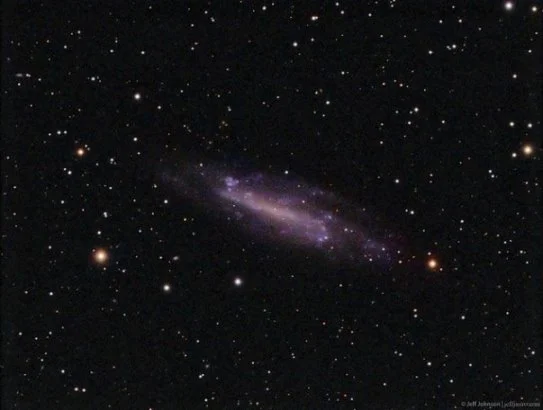
NGC 4236, image: Jeffrey O. Johnson at jeffastro.com, (CC BY-SA 4.0)
NGC 7023 (Caldwell 4): Iris Nebula
The Iris Nebula (C4) is a magnitude 6.8 reflection nebula 1,300 light years away in Cepheus. The nebula has an apparent size of 18 arcminutes. The central star, SAO 19158, shines at magnitude 7.4. The New General Catalogue designation NGC 7023 refers to the open cluster embedded in the nebula.
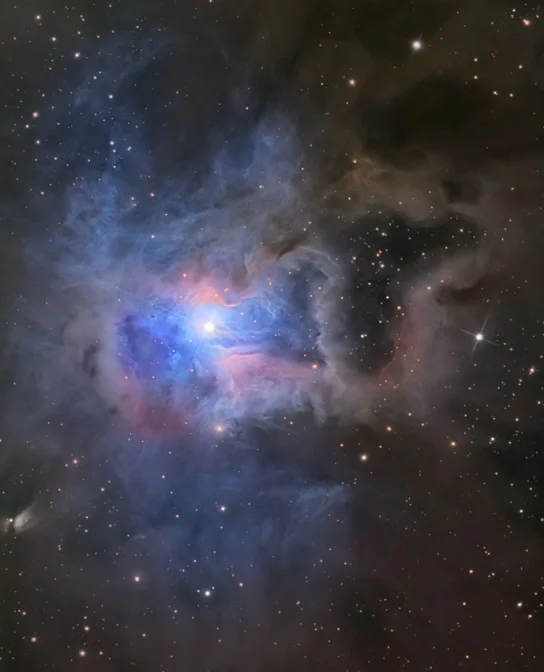
The Iris Nebula (NGC 7023), image: Adam Block/Mount Lemmon SkyCenter/University of Arizona
IC 342 (Caldwell 5): Hidden Galaxy
IC 342 (C5) is an intermediate spiral galaxy in Camelopardalis. It lies approximately 10.7 million light years away. The galaxy has an apparent magnitude of 9.1 and an apparent size of 21.4 by 20.9 arcminutes. It was nicknamed the Hidden Galaxy because it lies in a dusty region near the galactic equator and can be challenging to observe.
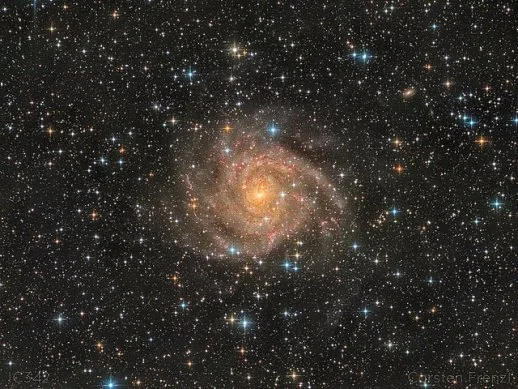
IC 342, image: Carsten Frenzl (CC BY 2.0)
NGC 6543 (Caldwell 6): Cat’s Eye Nebula
The Cat’s Eye Nebula (C6) is a planetary nebula approximately 3,300 light years away in the constellation Draco. It has an apparent magnitude of 9.8. The nebula’s central region is 20 arcseconds across. Named for its peculiar appearance, the Cat’s Eye is known for being the first nebula studied by English amateur astronomer William Huggins, who demonstrated that planetary nebulae were gaseous and not stellar in nature. Huggins examined the nebula’s spectrum in August 1864 and concluded, “Not an aggregation of stars, but a luminous gas.”
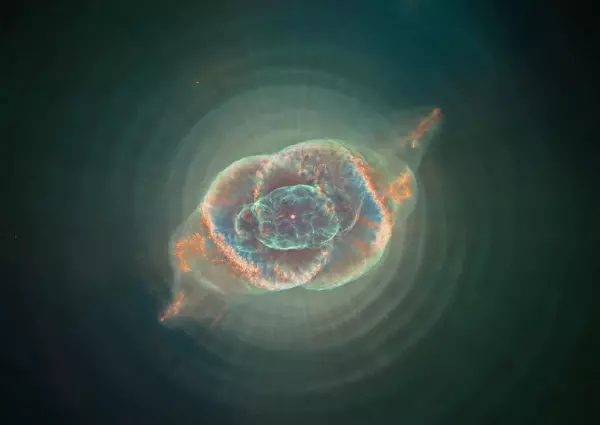
Staring across interstellar space, the alluring Cat’s Eye Nebula lies 3,000 light-years from Earth. The Cat’s Eye (NGC 6543) represents a brief, yet glorious, phase in the life of a sun-like star. This nebula’s central star may have produced the simple, outer pattern of dusty concentric shells by shrugging off outer layers in a series of regular convulsions. But the formation of the beautiful, more complex inner structures is not well understood. Here, Hubble Space Telescope archival image data have been reprocessed to create another look at the cosmic cat’s eye. Compared to well-known Hubble pictures, the alternative processing strives to sharpen and improve the visibility of details in light and dark areas of the nebula and also applies a more complex color palette. Of course, gazing into the Cat’s Eye, astronomers may well be seeing the fate of our sun, destined to enter its own planetary nebula phase of evolution… in about 5 billion years. Image: Hubble Space Telescope
NGC 2403 (Caldwell 7)
NGC 2403 (C7) is an intermediate spiral galaxy located approximately 9.65 million light years away in the constellation Camelopardalis. It has an apparent magnitude of 8.9 and appears similar to the Triangulum Galaxy (Messier 33). NGC 2403 occupies an area of 21.9 by 12.3 arcminutes. It is an outlying member of the M81 Group.
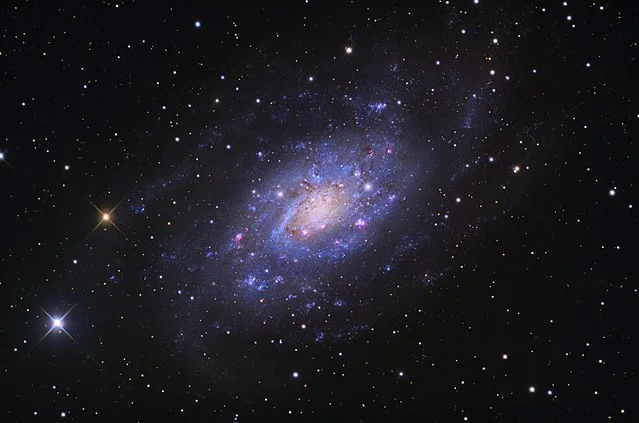
NGC 2403, image: Adam Block/Mount Lemmon SkyCenter/University of Arizona (CC BY-SA 4.0)
NGC 559 (Caldwell 8)
NGC 559 (C8) is an open star cluster about 7,200 light years away in Cassiopeia. It lies in the region between Segin (Epsilon Cassiopeiae) and Gamma Cassiopeiae, the leftmost and central stars of Cassiopeia’s W. The cluster has an apparent magnitude of 9.5 and an apparent size of 7 arcminutes.
Sharpless 155 (Caldwell 9): Cave Nebula
The Cave Nebula (C9, Sh2-155) is a diffuse nebula approximately 2,400 light years away in Cepheus. It lies in the same region of the sky as the Bubble Nebula (C11) and the open cluster Messier 52. The nebula has an apparent magnitude of 7.7 and an apparent size of 50 by 30 arcminutes. It is 35 light years across. It was named the Cave Nebula by Sir Patrick Moore.
NGC 663 (Caldwell 10)
NGC 663 (C10) is a bright open cluster located between Segin and Ruchbah (Epsilon and Delta Cassiopeiae) in Cassiopeia constellation. The cluster has an apparent magnitude of 7.1 and lies 6,850 light years away. It is 16 arcminutes across.
NGC 7635 (Caldwell 11): Bubble Nebula
The Bubble Nebula (C11) is an emission nebula in Cassiopeia. It has an apparent magnitude of about 10 and an apparent size of 15 by 8 arcminutes. Also catalogued as Sharpless 162 (Sh2-162), the nebula is known for its unique shape. It is a popular target for astrophotography and appears in the same wide field as the open cluster Messier 52.
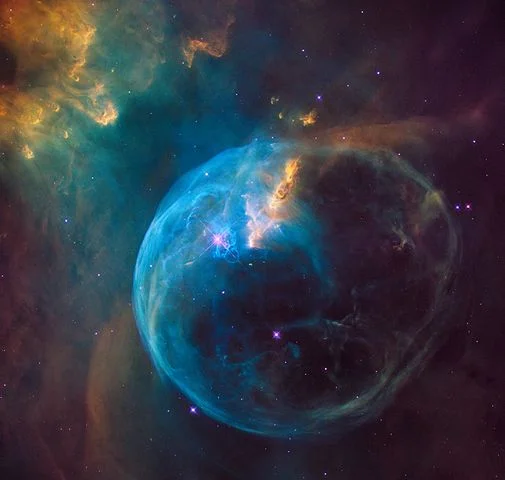
For the 26th birthday of NASA’s Hubble Space Telescope, astronomers are highlighting a Hubble image of an enormous bubble being blown into space by a super-hot, massive star. The Hubble image of the Bubble Nebula, or NGC 7635, was chosen to mark the 26th anniversary of the launch of Hubble into Earth orbit by the STS-31 space shuttle crew on April 24, 1990. Image: NASA, ESA, and the Hubble Heritage Team (STScI/AURA)
NGC 6946 (Caldwell 12): Fireworks Galaxy
The Fireworks Galaxy (C12) is an intermediate spiral galaxy located approximately 25.2 million light years away on the border between Cepheus and Cygnus. The galaxy has an apparent magnitude of 9.6 and appears face-on. It is classified as a starburst galaxy. It is famous for hosting 10 observed supernovae in the last century (from 1917 to 2017), more than any other known galaxy.
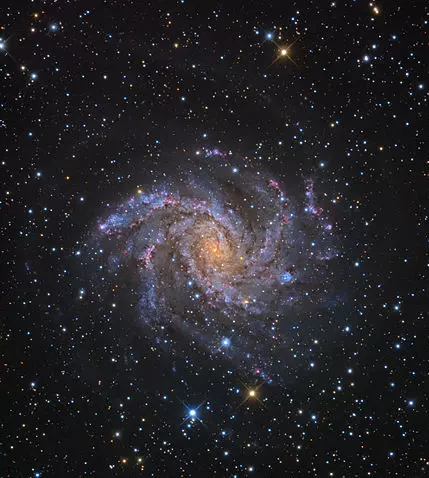
The Fireworks Galaxy, image: Adam Block/Mount Lemmon SkyCenter/University of Arizona (CC BY-SA 4.0)
NGC 457 (Caldwell 13): Owl Cluster (E. T. Cluster)
The Owl Cluster (C13) is a bright open star cluster located 7,922 light years away in the constellation Cassiopeia. At magnitude 6.4, the cluster is easily seen in binoculars. It has an apparent size of 13 arcminutes. It is also known as the E. T. Cluster, Dragonfly Cluster, or Phi Cassiopeiae Cluster, after its brightest member, which appears as one of the owl’s eyes.
NGC 869 and NGC 884 (Caldwell 14): Double Cluster
The Double Cluster (C14) is a pair of bright open clusters located in the constellation Perseus. The two clusters – NGC 869 and NGC 884 – have apparent magnitudes of 3.7 and 3.8 and lie 7,460 and 7,640 light years away. They appear close together in the sky. Both are visible to the unaided eye, appearing as bright patches between Cassiopeia’s W and the Segment of Perseus. They are also known as h and χ (chi) Persei.
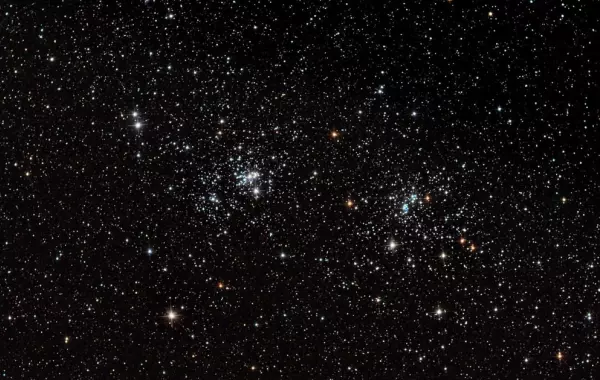
The Double Cluster (NGC 869 and NGC 884) in Perseus. Image: Rawastrodata (Nikon D300 camera on an 8″ Newtonian reflector)
NGC 6826 (Caldwell 15): Blinking Planetary Nebula
The Blinking Planetary Nebula (C15) is a planetary nebula about 2,000 light years away in the constellation Cygnus. It has an apparent magnitude of 8.8 and an apparent size of 27 by 24 arcseconds. The nebula’s central hot remnant star is one of the brightest stars in any planetary nebula. The nebula is faint compared to the star and appears to “blink” or disappear from view when observed through the eyepiece of a telescope.
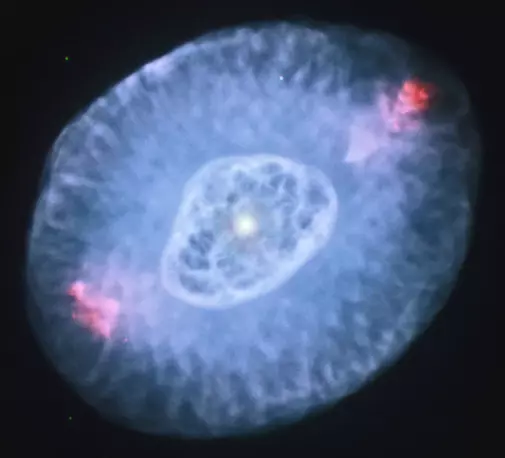
The Blinking Planetary Nebula, image: Judy Schmidt (CC BY 2.0)
NGC 7243 (Caldwell 16)
NGC 7243 (C16) is a bright open cluster 2,800 light years away in the constellation Lacerta. It has an apparent magnitude of 6.4 and spans 21 arcminutes of the sky. It forms a triangle with Alpha and Beta Lacertae. The cluster is believed to be just over 100 million years old. It is composed primarily of blue and white stars.
NGC 147 (Caldwell 17)
NGC 147 (C17) is a dwarf spheroidal galaxy approximately 2.58 million light years away in Cassiopeia. It appears near the star Omicron Cassiopeiae and another dwarf spheroidal galaxy, NGC 185 (C18), with which it forms a physical pair. NGC 147 has an apparent magnitude of 10.5 and an apparent size of 13.2 by 7.8 arcminutes. It is a member of the Local Group and a satellite of the Andromeda Galaxy.
NGC 185 (Caldwell 18)
NGC 185 (C18) is a dwarf spheroidal galaxy 2.05 million light years away in Cassiopeia. It has an apparent magnitude of 10.1 and an apparent size of 11.7 by 10 arcminutes. Like its close neighbour NGC 147, it is a satellite galaxy of the Andromeda Galaxy and a member of the Local Group of galaxies. It has an active galactic nucleus and is the only known Seyfert galaxy in the Local Group.
IC 5146 (Caldwell 19): Cocoon Nebula
The Cocoon Nebula (C19) is a reflection/emission nebula located about 2,500 light years away in the constellation Cygnus. It has an apparent magnitude of 7.2 and spans 12 arcminutes of the sky. The nebula is associated with the open cluster Collinder 470 (IC 5146). It lies in the same region of the sky as the brighter open cluster Messier 39, near the star Pi Cygni.
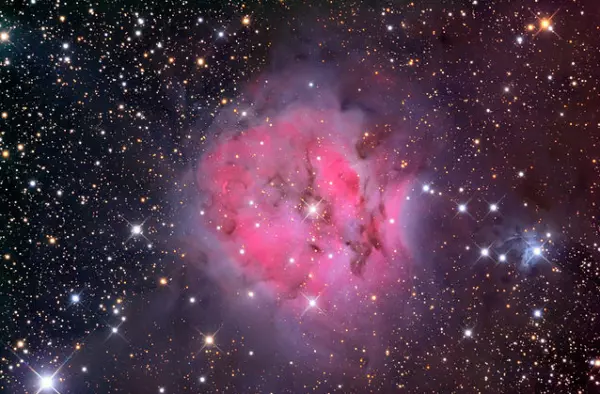
Cocoon Nebula (IC 5146), image: Adam Block/Mount Lemmon SkyCenter/University of Arizona (CC BY-SA 3.0 US)
NGC 7000 (Caldwell 20): North America Nebula
The North America Nebula (C20) is a large emission nebula about 2,590 light years away in Cygnus. It appears near Deneb, the constellation’s brightest star, and makes a striking visual pair with the nearby Pelican Nebula (IC 5070). NGC 7000 was named for its shape, which resembles that of the North America continent. It has an apparent magnitude of 4 and an apparent size of 120 by 100 arcminutes. The entire nebula is believed to be 140 light years across.
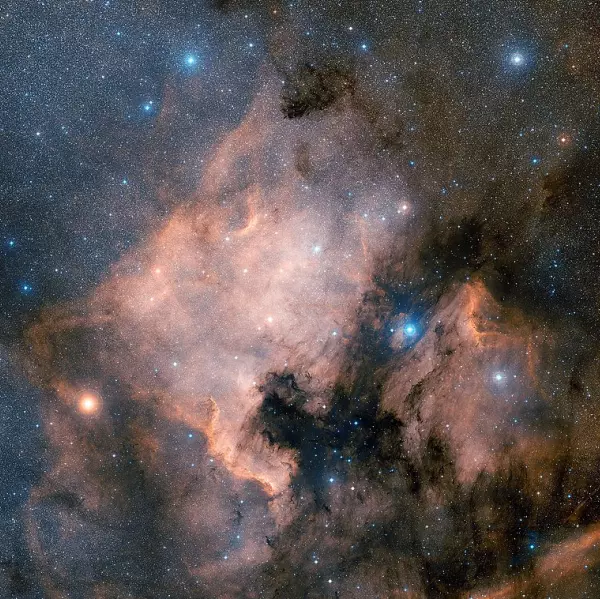
North America Nebula (NGC 7000), image: NASA
NGC 4449 (Caldwell 21)
NGC 4449 (C21) is an irregular Magellanic-type galaxy approximately 12 million light years away in the constellation Canes Venatici. It lies in the same region of the sky as the bright spiral galaxies Messier 94 and Messier 106 and is a member of the M94 Group of galaxies. NGC 4449 has an apparent magnitude of 10 and an apparent size of 6.2 by 4.4 arcminutes.
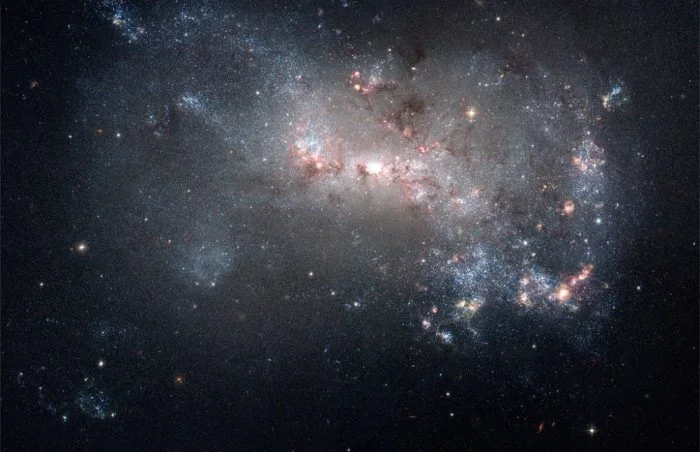
Hundreds of thousands of vibrant blue and red stars blaze in this image taken by NASA’s Hubble Space Telescope. Hot bluish-white clusters of massive stars are scattered throughout the galaxy, interspersed with numerous dustier, reddish regions of current star formation. Massive dark clouds of gas and dust are silhouetted against the starlight. NGC 4449 has been forming stars for several billion years, but currently it is experiencing a star formation event at a much higher rate than in the past. This unusually intense star formation activity qualifies as a starburst. At the current rate, the gas supply that feeds the stellar production would only last for another billion years or so. Starbursts usually occur in the central regions of galaxies, but NGC 4449 has more widespread star formation activity, since the very youngest stars are observed both in the nucleus and in streams surrounding the galaxy. A global starburst like NGC 4449 resembles primordial star forming galaxies, which grew by merging with and accreting smaller stellar systems. Since NGC 4449 is close enough to be observed in great detail, it is the ideal laboratory for the investigation of what may have occurred during galactic formation and evolution in the early universe. It’s likely that the current widespread starburst was triggered by interaction or merging with a smaller companion. NGC 4449 belongs to a group of galaxies in the constellation Canes Venatici. Astronomers think that NGC 4449’s star formation has been influenced by interactions with several of its neighbors. Image: NASA, ESA, A. Aloisi (STScI/ESA), and The Hubble Heritage (STScI/AURA)-ESA/Hubble Collaboration
NGC 7662 (Caldwell 22): Blue Snowball Nebula
The Blue Snowball Nebula (C22) is a planetary nebula located near the asterism known as Frederick’s Glory in the constellation Andromeda. The nebula has an apparent magnitude of 8.6 and an apparent size of 37 arcseconds. It stretches 0.8 light years across. Distance estimates are in the range from 2,000 to 6,000 light years.
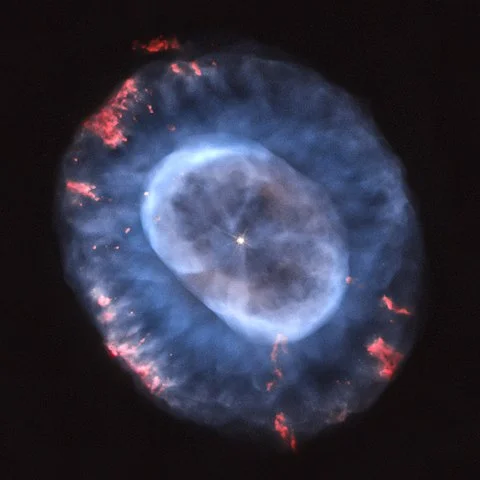
Caldwell 22, also cataloged as NGC 7662 and nicknamed the Snowball Nebula or Blue Snowball Nebula, is a planetary nebula located about 2,500 light-years from Earth. Nebulas like these represent a stage in evolution that stars like our Sun undergo when they run out of fuel. Stars are nuclear furnaces that spend most of their lives fusing hydrogen into helium. Massive stars have fiery fates, going out as supernovae, but medium-mass stars like the Sun swell to become red giants as they exhaust their fuel. The process begins when, after billions of years of nuclear fusion, the star starts to shut down. Gravity (no longer balanced by the outward pressure created by nuclear fusion) compresses the stellar core. The star’s outer layers of gas puff away into space, creating a planetary nebula (so named because these objects often resemble planetary orbs when viewed through a small telescope). At the center lie the remains of the original star’s compressed core, a small white dwarf. One day the Sun will meet a similar fate, but it has enough fuel to last another 6 billion years or so. This image was taken using Hubble’s Wide Field and Planetary Camera 2 in 2000. Astronomers compared this image to earlier Hubble images of Caldwell 22 to study how the nebula expanded and changed. Credit: NASA, ESA and A. Hajian (University of Waterloo)
NGC 891 (Caldwell 23): Silver Sliver Galaxy (Outer Limits Galaxy)
NGC 891 (C23) is an unbarred spiral galaxy appearing edge-on, located roughly between Messier 34 in Perseus and Almach in Andromeda. Popularly known as the Silver Sliver Galaxy or the Outer Limits Galaxy, the galaxy lies approximately 27.3 million light years away in the constellation Andromeda. It has an apparent magnitude of 10.8 and an apparent size of 13.5 by 2.5 arcminutes. It is a member of the NGC 1023 Group of galaxies.
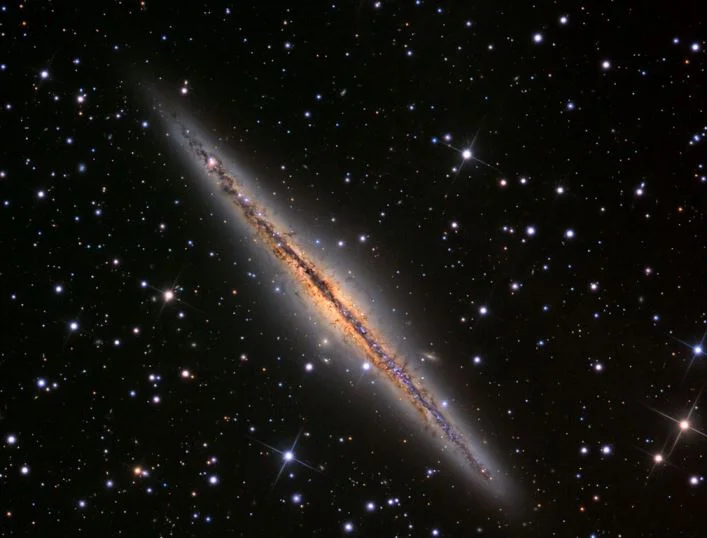
NGC 891, image: Adam Block/Mount Lemmon SkyCenter/University of Arizona (CC BY-SA 3.0 US)
NGC 1275 (Caldwell 24): Perseus A
NGC 1275 (C24) is a Seyfert galaxy located 222 million light years away in Perseus. It corresponds to the radio galaxy Perseus A. The galaxy appears just east of Algol. It is a member of the Perseus Cluster of galaxies. It has an apparent magnitude of 12.6 and an apparent size of 2.2 by 1.7 arcminutes.
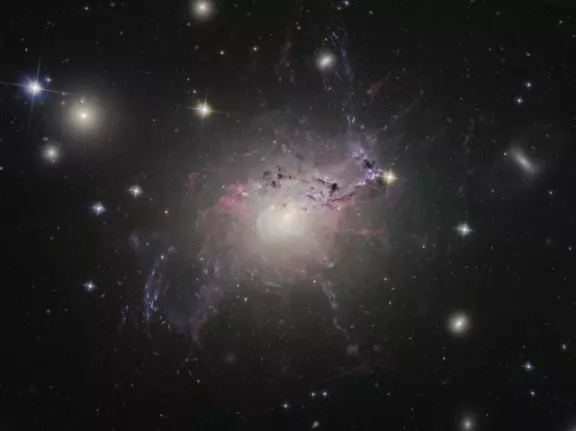
NGC 1275, image: Judy Schmidt (CC BY 2.0)
NGC 2419 (Caldwell 25): Intergalactic Wanderer
NGC 2419 (C25) is a globular cluster located 275,000 light years away in the constellation Lynx. It appears in the region of the sky above Castor in Gemini. The cluster has an apparent magnitude of 9.06 and an apparent size of 6 arcminutes. It is 260 light years across. Its estimated age is 12.3 billion years. The cluster was nicknamed the Intergalactic Wanderer because it was once believed not to be in orbit around the Milky Way. It is now known to orbit out galaxy, taking 3 billion years to complete an orbit.
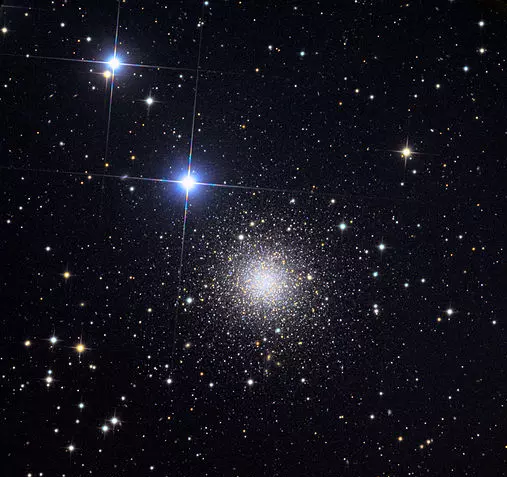
Intergalactic Wanderer (NGC 2419), image: Adam Block, Mount Lemmon SkyCenter, University of Arizona (CC BY-SA 3.0)
NGC 4244 (Caldwell 26)
NGC 4244 (C26) is an edge-on spiral galaxy 14.1 million light years away in the constellation Canes Venatici. It has an apparent magnitude of 10.44 and an apparent size of 17 by 2.2 arcminutes. The galaxy appears in the same area of the sky as the Sun-like star Chara (Beta Canum Venaticorum) and is a member of the M94 Group.
NGC 6888 (Caldwell 27): Crescent Nebula
The Crescent Nebula (C27) is an emission nebula located approximately 5,000 light years away in the constellation Cygnus. It appears about 2 degrees southwest of Sadr, the star at the centre of the Northern Cross. The nebula has an apparent size of 18 by 12 arcminutes and an apparent magnitude of 7.4. Its central star is a hot, luminous Wolf-Rayet star designated WR 136. The star has a mass 21 times that of the Sun and is about 600,000 times more luminous. The nebula was formed by the collision of the stellar wind from WR 136 and the slower moving material expelled from the star when it became a red giant hundreds of thousands of years ago. It can be seen in a small telescope with UHC or OIII filters.
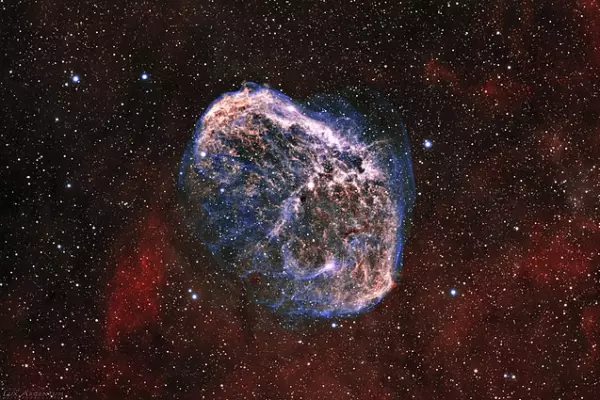
Crescent Nebula, image: Patrick Hsieh (CC BY-SA 4.0)
NGC 752 (Caldwell 28)
NGC 752 (C28) is a bright open star cluster about 1,300 light years away in Andromeda, near the border with Triangulum. With an apparent magnitude of 5.7 and an apparent size of 75 arcminutes, it is easily observed in binoculars. The cluster has 258 confirmed members. Its estimated age is about 1.34 billion years.
NGC 5005 (Caldwell 29)
NGC 5005 (C29) is a spiral galaxy approximately 65 million light years away in the constellation Canes Venatici. It has an apparent magnitude of 10.6 and high surface brightness. It can be seen in larger amateur telescopes. NGC 5005 forms a physical pair with the magnitude 10.8 spiral galaxy NGC 5033.
NGC 7331 (Caldwell 30)
NGC 7331 (C30) is an unbarred spiral galaxy in the constellation Pegasus. It has an apparent magnitude of 10.4 and an apparent size of 10.5 by 3.7 arcminutes. The galaxy is the brightest member of the NGC 7331 Group, a visual grouping of five galaxies also known as the Deer Lick Group. NGC 7331 is sometimes called the Milky Way’s twin because it has a similar size and structure. The galaxy has a diameter of 120,000 light years and lies approximately 39.8 million light years away.
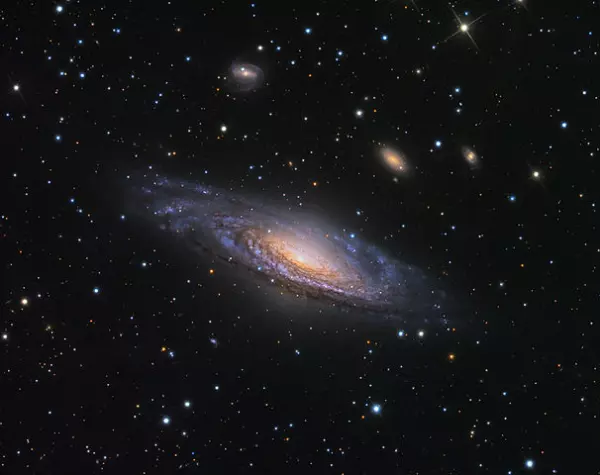
NGC 7331, image: NGC 7331, image: Adam Block/Mount Lemmon SkyCenter/University of Arizona (CC BY-SA 3.0 US)
IC 405 (Caldwell 31): Flaming Star Nebula
The Flaming Star Nebula (C31) is an emission and reflection nebula about 1,500 light years away in Auriga. It has an apparent magnitude of 6.0 and an apparent size of 37 by 19 arcminutes. The nebula is about 5 light years in diameter. It lies between Mahasim and Hassaleh (Theta and Iota Aurigae), in the same area of the sky as the open clusters Messier 36 and Messier 38. The Flaming Star Nebula surrounds the hot blue runaway star AE Aurigae. The star was not formed within the nebula – its origins have been traced to the Trapezium Cluster in the Orion Nebula – but is merely passing though it and energizing it with its light.
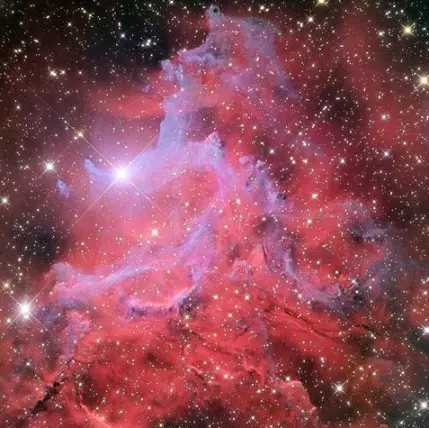
AE Aurigae and the Flaming Star Nebula (IC 405), image: Adam Block/Mount Lemmon SkyCenter/University of Arizona (CC BY-SA 3.0 US)
NGC 4631 (Caldwell 32): Whale Galaxy
The Whale Galaxy (C32) is a barred spiral galaxy 30 million light years away in Canes Venatici. It has an apparent magnitude of 9.8 and an apparent size of 15.5 by 2.7 arcminutes. The galaxy appears edge-on and its slightly distorted shape with a central starburst region gives it the appearance of a whale. NGC 4631 appears in the same area as the Hockey Stick Galaxy (NGC 4656 and NGC 4657).
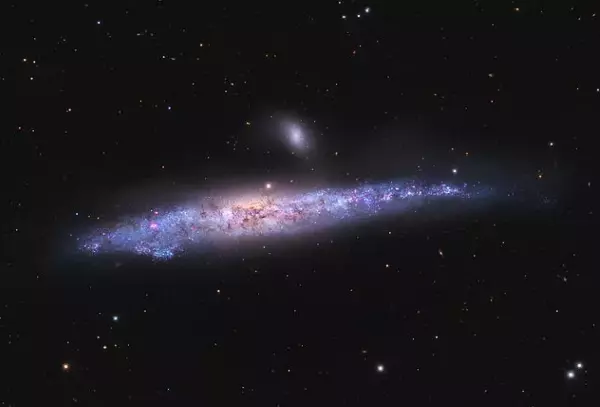
Whale Galaxy (NGC 4631), image: Adam Block/Mount Lemmon SkyCenter/University of Arizona (CC BY-SA 3.0 US)
NGC 6992 (Caldwell 33): East Veil Nebula
The Veil Nebula is a large supernova remnant near Aljanah (Epsilon Cygni) in the constellation Cygnus. It lies 2,400 light years away and has a radius of 65 light years. The progenitor star ended its life between 10,000 and 20,000 years ago and the remnant has since expanded to cover 3 degrees of the sky. Its various portions have separate designations in the New General Catalogue.
The East Veil Nebula (C33) is catalogued as NGC 6992. It trails south into NGC 6995 and IC 1340. Together with NGC 6995, it is known as the Network Nebula.
NGC 6960 (Caldwell 34): West Veil Nebula
The West Veil Nebula (C34) is also known as the Witch’s Broom, Filamentary Nebula or Lacework Nebula. It appears near the magnitude 4.22 yellow giant 52 Cygni. It is one of three main visual components of the Veil Nebula, along with the Eastern Veil and Fleming’s Triangle (Pickering’s Triangle).
NGC 4889 (Caldwell 35): Coma B
NGC 4889 (C35) is a supergiant elliptical galaxy approximately 308 million light years away in the constellation Coma Berenices. It is one of two supergiant elliptical galaxies dominating the centre of the Coma Cluster, along with NGC 4874. The galaxy has an apparent size of 2.9 by 1.9 arcminutes and an apparent magnitude of 12.9. It hosts a supermassive black hole at its centre. A large population of globular clusters are orbiting the galaxy. NGC 4889 appears in the region between Beta and Gamma Comae Berenices. It can be seen in 12-inch telescopes. In small telescopes, it can only be glimpsed as a faint patch in good condition.
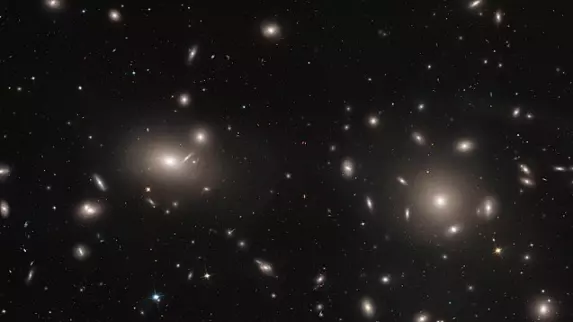
Elements of the Coma Cluster of galaxies. Three of the galaxies seen in this image are IC 4040 (left edge) NGC 4889 (center-left) NGC 4874 (center-right). The bright star in the upper right is HD 112887. Image: Adam Block/Mount Lemmon SkyCenter/University of Arizona
NGC 4559 (Caldwell 36)
NGC 4559 (C36) is an intermediate spiral galaxy located approximately 29 million light years away in Coma Berenices. It has an apparent magnitude of 10.4 and an apparent size of 10.7 by 4.4 arcminutes. It is a member of the Coma I Group of galaxies.
NGC 6885 (Caldwell 37)
NGC 6885 (C37) is an open cluster in the constellation Vulpecula. It lies in the same region of the sky as the Dumbbell Nebula (Messier 27), close to the open cluster NGC 6882. The central star in NGC 6885 is 20 Vulpeculae, a magnitude 5.91 B-type main sequence star. The cluster lies 1,950 light years away.
NGC 4565 (Caldwell 38): Needle Galaxy
The Needle Galaxy (C38) is an edge-on spiral galaxy 30 – 50 million light years away in Coma Berenices. It has an apparent magnitude of 10.42 and an apparent size of 15.90 by 1.85 arcminutes. It appears south of NGC 4559 (C36). NGC 4565 has at least two satellite galaxies and hosts about 240 globular clusters. It is one of the brightest members of the Coma I Group.
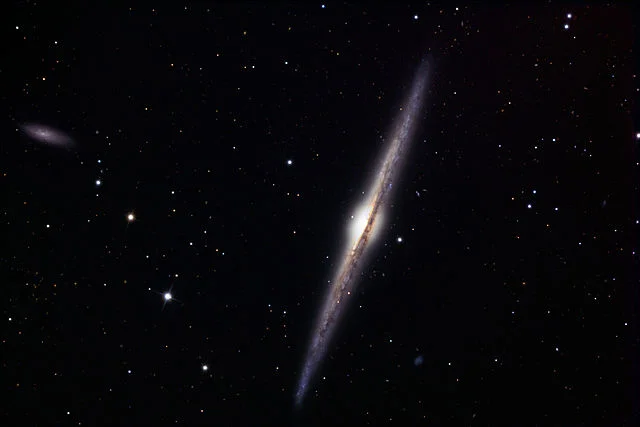
NGC 4565 and NGC 4562, image: Wikimedia Commons/ Jschulman555 (CC BY 3.0)
NGC 2392 (Caldwell 39): Clown Face Nebula
NGC 2392 (C39) is a planetary nebula about 6,520 light years away in the constellation Gemini. It has an apparent magnitude of 10.1 and an apparent size of 48 arcseconds. The nebula can be seen in small telescopes. Its central star is an O-type star of the spectral type O(H)6f.
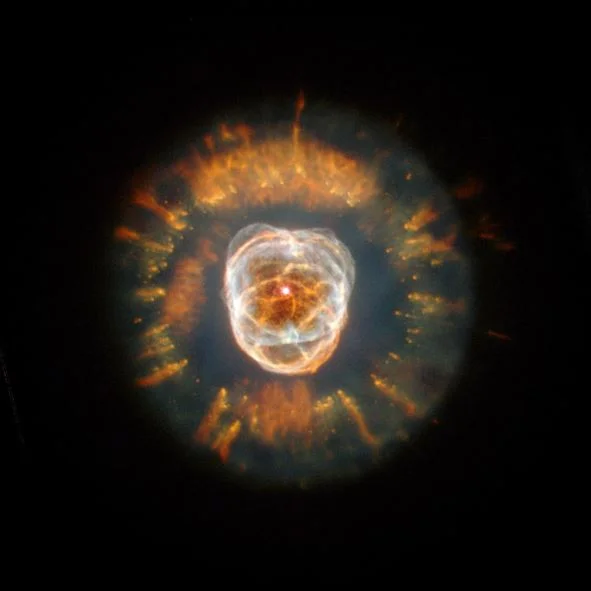
Eskimo nebula (NGC 2392). In its first glimpse of the heavens following the successful December 1999 servicing mission, NASA’s Hubble Space Telescope captured a majestic view of a planetary nebula, the glowing remains of a Sun-like star. This stellar relic, first spied by William Herschel in 1787, is nicknamed the “Eskimo” Nebula (NGC 2392) because, when viewed through ground-based telescopes, it resembles a face surrounded by a fur parka.
In this Hubble telescope image, the “parka” is really a disk of material embellished with a ring of comet-shaped objects, with their tails streaming away from the central star. The Eskimo’s “face” also contains some fascinating details. Although this bright central region resembles a ball of twine, it is, in reality, a bubble of material being blown into space by the central star’s intense “wind” of high-speed material. Image: NASA, ESA, Andrew Fruchter (STScI), and the ERO team (STScI + ST-ECF)
NGC 3626 (Caldwell 40)
NGC 3626 (C40) is an unbarred lenticular galaxy 74.72 million light years away in the constellation Leo. It has an apparent magnitude of 10.98 and an apparent size of 2.7 by 1.9 arcminutes. The galaxy lies near the magnitude 2.56 star Zosma (Delta Leonis). It is a member of the NGC 3607 Group.
Hyades (Caldwell 41)
The Hyades cluster (C41, Melotte 25) is a bright, large open cluster in the constellation Taurus. Its brightest stars outline the Bull’s V-shaped head. The cluster appears in the same line of sight as Aldebaran, the brightest star in Taurus. With an apparent magnitude of 0.5 and an apparent size of 330 arcminutes, C41 is easily seen without binoculars. At a distance of 153 light years, it is the nearest open cluster to the Sun.
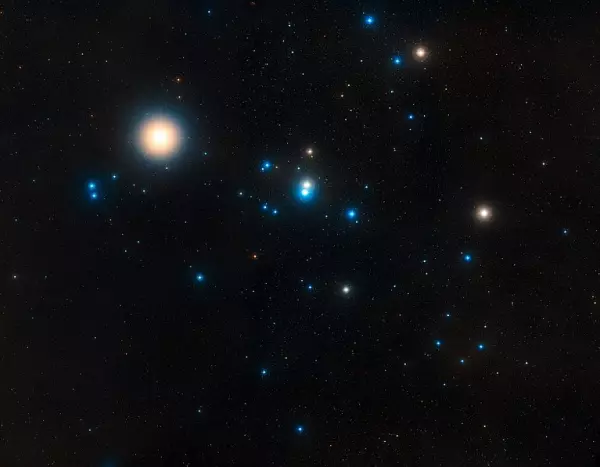
This image shows the Hyades star cluster, the nearest cluster to us. The Hyades cluster is very well studied due to its location, but previous searches for planets have produced only one. A new study led by Jay Farihi of the University of Cambridge, UK, has now found the atmospheres of two burnt-out stars in this cluster — known as white dwarfs — to be “polluted” by rocky debris circling the star. Seeing evidence of asteroids points to the possibility of Earth-sized planets in the same system, as asteroids are the building blocks of major planets. Planet-forming processes are inefficient, and spawn many times more small bodies than large bodies — but once rocky embryos the size of asteroids are built, planets are sure to follow. Image: NASA, ESA, and STScI
NGC 7006 (Caldwell 42)
NGC 7006 (C42) is a globular cluster 135,000 light years away in the constellation Delphinus. It has an apparent magnitude of 10.6 and occupies 2.8 arcminutes of the apparent sky. The cluster is part of the galactic halo.
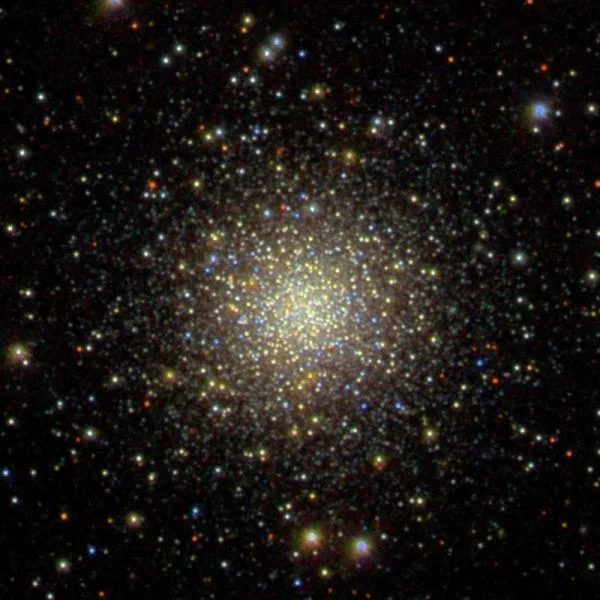
NGC 7006, image: Sloan Digital Sky Survey
Little Sombrero Galaxy – NGC 7814 (Caldwell 43)
NGC 7814 (C43) is a spiral galaxy in the constellation Pegasus. It lies approximately 40 million light years away and appears near Algenib (Gamma Pegasi) within the Great Square of Pegasus. The galaxy has an apparent magnitude of 11.6 and appears edge-on. It has an apparent size of 5.5 by 2.3 arcminutes. Due to its similarity to the Sombrero Galaxy (Messier 104), it is sometimes called the Little Sombrero.
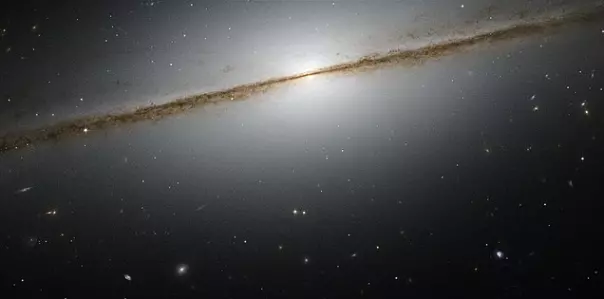
NGC 7814, image: NASA (Hubble Space Telescope)
NGC 7479 (Caldwell 44): Propeller Galaxy (Superman Galaxy)
NGC 7479 (C44) is a magnitude 11.6 barred spiral galaxy approximately 105 million light years away in Pegasus. The galaxy appears south of Markab (Alpha Pegasi). It has an apparent size of 4.1 by 3.1 arcminutes.
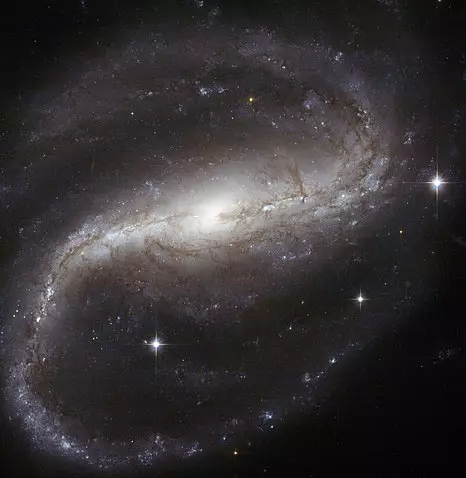
In this Hubble image of Caldwell 44, also known as NGC 7479, the tightly wound arms of the barred spiral galaxy create a backward “S” as they spin in a counter-clockwise direction. However, this galaxy, nicknamed the Propeller galaxy, emits a jet of radiation in radio wavelengths that bends in the opposite direction to the stars and dust in the arms of the galaxy. Astronomers think that the radio jet was put into its bizarre backward spin after the Propeller galaxy merged with another galaxy. The Propeller galaxy is an interesting subject for several other reasons as well. Hidden within the galaxy’s core lurks a supermassive black hole that feeds on large quantities of gas. The galaxy has also been the home to two recent supernovae, one witnessed in 1990 and the other in 2009. Image: NASA (Hubble Space Telescope)
NGC 5248 (Caldwell 45)
NGC 5248 (C45) is an intermediate spiral galaxy located in the constellation Boötes. It lies about 59 million light years away. It has an apparent magnitude of 10.97 and an apparent size of 6.2 by 4.5 arcminutes. The galaxy is a member of the NGC 5248 Group.
NGC 2261 (Caldwell 46): Hubble’s Variable Nebula
Hubble’s Variable Nebula (C46) is a variable reflection nebula located about 2,500 light years away in the constellation Monoceros. The nebula appears south of the Christmas Tree Cluster. It looks like a small comet that changes in shape and brightness over weeks and months. The nebula has an apparent magnitude of 9.0 and an apparent size of 2 arcminutes. It is illuminated by the variable star R Monocerotis, a young pre-main sequence star obscured from visual sight by a circumstellar disk of gas and dust.
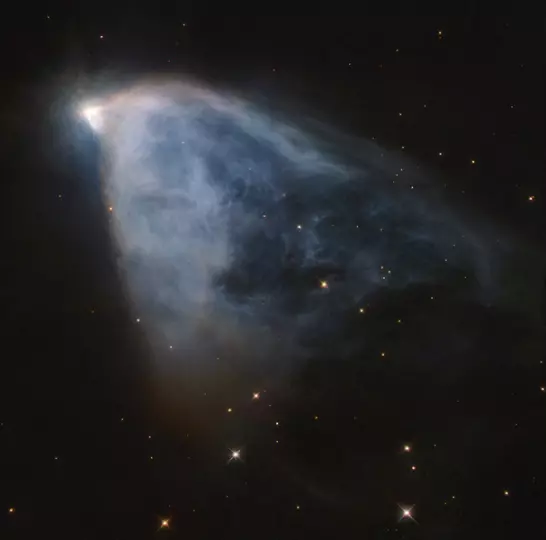
Hubble’s Variable Nebula (NGC 2261), image: Judy Schmidt (CC BY 2.0)
NGC 6934 (Caldwell 47)
NGC 6934 (C47) is a globular cluster 52,000 light years away in the constellation Delphinus. It has an apparent magnitude of 8.83 and an apparent size of 1.20 arcminutes. It appears south of the blue giant Aldulfin (Epsilon Delphini).
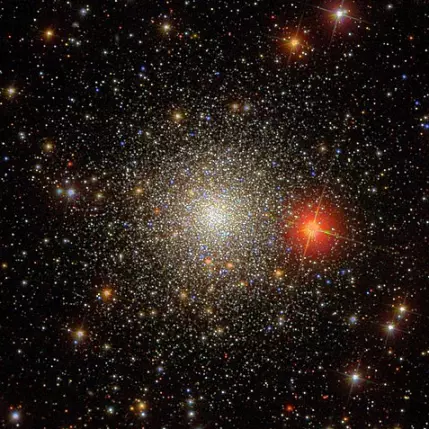
NGC 6934, image: Sloan Digital Sky Survey
NGC 2775 (Caldwell 48)
NGC 2775 (C48) is a spiral galaxy approximately 67 million light years away in the constellation Cancer. It has an apparent magnitude of 10.4 and an apparent size of 4.3 by 3.3 arcminutes. It is the brightest member of the NGC 2775 Group.
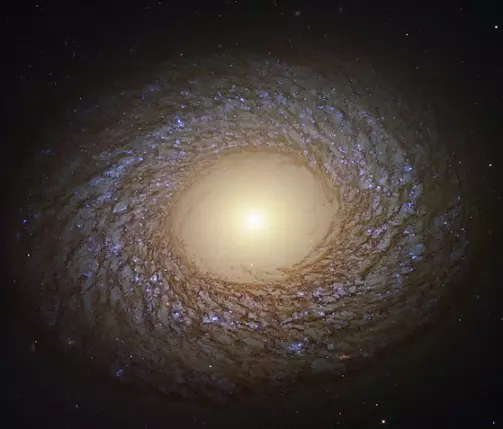
This Hubble image shows a flocculent spiral galaxy called NGC 2775. The image was made from separate exposures taken in the visible, ultraviolet and near-infrared regions of the spectrum with Hubble’s Wide Field Camera 3 (WFC3). It is based on data obtained through five filters. The color results from assigning different hues to each monochromatic image associated with an individual filter. Image credit: NASA/ESA/Hubble/J. Lee/PHANGS-HST Team/Judy Schmidt, www.geckzilla.com.
NGC 2237 (Caldwell 49): Rosette Nebula
The Rosette Nebula (C49) is a large H II region located 5,200 light years away in Monoceros. It appears just south of the imaginary line connecting Procyon in Canis Minor and Betelgeuse in Orion. The nebula has an apparent magnitude of 9.0 and an apparent size of 1.3 degrees. It stretches about 130 light years in diameter. The entire complex has several designations in the New General Catalogue: NGC 2237, NGC 2238, NGC 2239, NGC 2244, and NGC 2246.
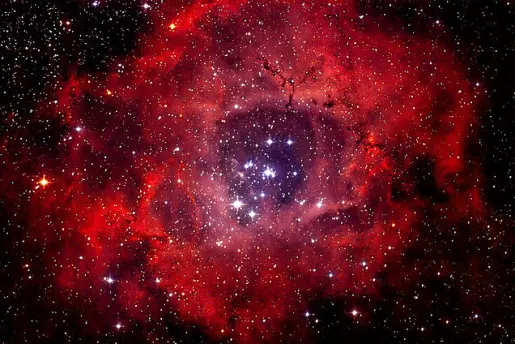
NGC 2244 and the Rosette Nebula, image: Andreas Fink (CC BY-SA 3.0)
NGC 2244 (Caldwell 50): Satellite Cluster
The Satellite Cluster (C50) is part of the Rosette Nebula complex. It is a young open cluster with an estimated age of less than 5 million years. The cluster has an apparent magnitude of 4.8 and an apparent size of 24 arcminutes. It is 36 light years across.
IC 1613 (Caldwell 51)
IC 1613 (C51) is an irregular dwarf galaxy about 2.38 million light years away in the constellation Cetus. It has an apparent magnitude of 9.9 and an apparent size of 16.2 by 14.5 arcminutes. The galaxy lies in our neighbourhood. It is a member of the Local Group.
NGC 4697 (Caldwell 52)
NGC 4697 (C52) is an elliptical galaxy approximately 38 million light years away in the constellation Virgo. It has an apparent magnitude of 10.97 and an apparent size of 4.4 by 2.8 arcminutes. The galaxy is the most prominent member of the NGC 4697 Group.
NGC 3115 (Caldwell 53): Spindle Galaxy
The Spindle Galaxy (C53) is a field lenticular galaxy located about 31.6 million light years away in the constellation Sextans. It appears almost exactly edge-on about 7 degrees south of Alpha Sextantis. The galaxy has an apparent magnitude of 9.9 and an apparent size of 7.2 by 2.5 arcminutes. It hosts a supermassive black hole with a mass of a billion Suns.
NGC 2506 (Caldwell 54)
NGC 2506 (C54) is an open cluster 12,700 light years away in Monoceros. It has an angular size of 12 arcminutes and an apparent magnitude of 7.6. Its core is 4.8 arcminutes across. The cluster itself has a physical radius of 18.5 light years. Its estimated age is about 2.09 billion years.
NGC 7009 (Caldwell 55): Saturn Nebula
The Saturn Nebula (C55) is a planetary nebula located at a distance of 2,000 – 4,000 light years in the constellation Aquarius. It appears a degree west of the magnitude 4.52 star Nu Aquarii. The nebula has an apparent magnitude of 8.0 and is visible in small telescopes. It has an apparent size of 41 by 35 arcseconds. The central region measures 25 by 17 arcseconds. The nebula’s central star is a hot bluish dwarf with a surface temperature of 55,000 K.
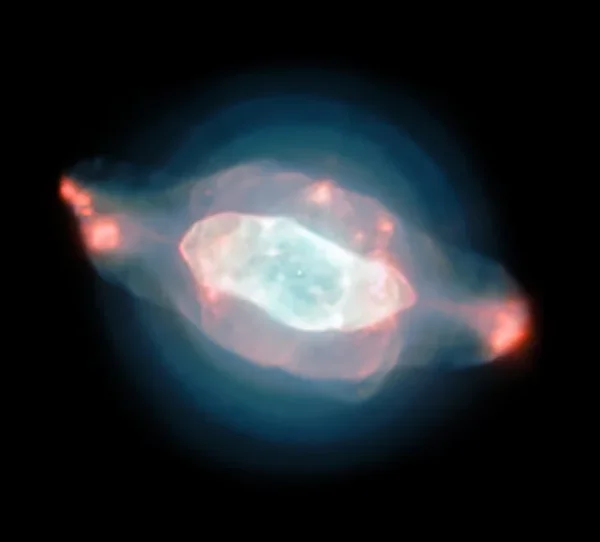
The spectacular planetary nebula NGC 7009, or the Saturn Nebula, emerges from the darkness like a series of oddly-shaped bubbles, lit up in glorious pinks and blues. This colourful image was captured by the powerful MUSE instrument on ESO’s Very Large Telescope (VLT), as part of a study which mapped the dust inside a planetary nebula for the first time. Image: ESO/J. Walsh, September 2017
NGC 246 (Caldwell 56): Skull Nebula
The Skull Nebula (C56) is a planetary nebula about 1,600 light years away in the constellation Cetus. It shares the nickname the Pac-Man Nebula with NGC 281 in Cassiopeia. The nebula has an apparent magnitude of 8 and is 3.733 arcminutes across. Its central star is a white dwarf with an apparent magnitude of 11.8.
NGC 6822 (Caldwell 57): Barnard’s Galaxy
Barnard’s Galaxy (C57) is a barred irregular galaxy located 1.63 million light years away in the constellation Sagittarius. It has an apparent magnitude of 9.3 and an apparent size of 15.5 by 13.5 arcminutes. The galaxy was named after the American astronomer Edward Emerson Barnard, who discovered it in 1884. It is one of the nearest galaxies to the Milky Way. It is about 7,000 light years across and hosts more than 150 known H II regions.
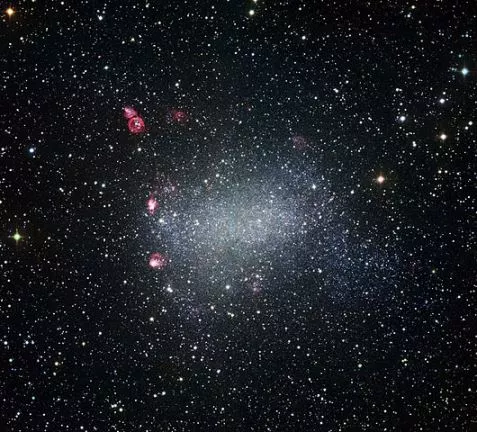
Astronomers obtained this portrait of Barnard’s Galaxy using the Wide Field Imager attached to the 2.2-metre MPG/ESO telescope at ESO’s La Silla Observatory in northern Chile. Also known as NGC 6822, this dwarf irregular galaxy is one of the Milky Way’s galactic neighbours. The dwarf galaxy has no shortage of stellar splendour and pyrotechnics. Reddish nebulae in this image reveal regions of active star formation, wherein young, hot stars heat up nearby gas clouds. Also prominent in the upper left of this new image is a striking bubble-shaped nebula. At the nebula’s centre, a clutch of massive, scorching stars send waves of matter smashing into surrounding interstellar material, generating a glowing structure that appears ring-like from our perspective. Other similar ripples of heated matter thrown out by feisty young stars are dotted across Barnard’s Galaxy. The image was made from data obtained through four different filters (B, V, R, and H-alpha). The field of view is 35 x 34 arcmin. Image: ESO
NGC 2360 (Caldwell 58): Caroline’s Cluster
Caroline’s Cluster (C58) is a magnitude 7.2 open cluster appearing east of Sirius in the constellation Canis Major. It has an angular size of 13 arcminutes and a physical diameter of 15 light years. It lies 3.5 degrees east of Muliphein (Gamma Canis Majoris). The cluster was named after the German astronomer Caroline Herschel, who discovered it on February 26, 1783. It lies 3,700 light years away.
NGC 3242 (Caldwell 59): Ghost of Jupiter
The Ghost of Jupiter (C59) is a planetary nebula approximately 4,800 light years away in the constellation Hydra. It has an apparent magnitude of 8.60 and an apparent size of 25 arcseconds. It is known as the Ghost of Jupiter because it has a similar size to the planet. It is sometimes also known as the Eye Nebula.
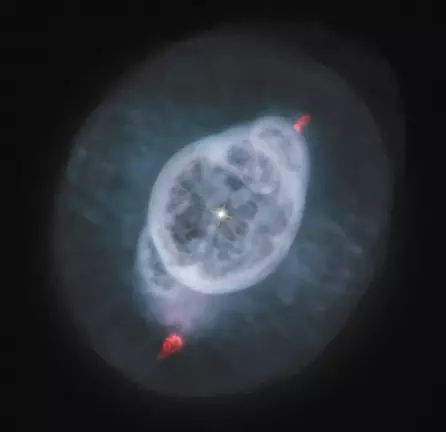
Ghost of Jupiter Nebula (NGC 3242), image: Judy Schmidt (CC BY 2.0)
NGC 4038 and NGC 4039 (Caldwell 60 and 61): Antennae Galaxies
The Antennae Galaxies (C60 and C61) are a pair of colliding galaxies in the constellation Corvus. Catalogued as NGC 4038 and NGC 4039, the galaxies have apparent magnitudes of 11.2 and 11.2 and lie 45 and 65 million light years away. They lie just west of Spica’s Spanker, an asterism formed by the brightest stars in Corvus. The galaxies are members of the NGC 4038 Group, which contains between 13 and 27 galaxies.
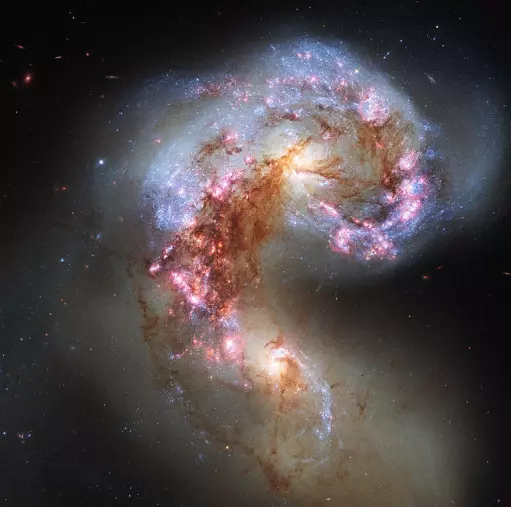
This image of the Antennae Galaxies shows obvious signs of chaos. Clouds of gas are seen in bright pink and red, surrounding the bright flashes of blue star-forming regions — some of which are partially obscured by dark patches of dust. The rate of star formation is so high that the Antennae Galaxies are said to be in a state of starburst, a period in which all of the gas within the galaxies is being used to form stars. This cannot last forever and neither can the separate galaxies; eventually the nuclei will coalesce, and the galaxies will begin their retirement together as one large elliptical galaxy. Image: ESA/Hubble & NASA
NGC 247 (Caldwell 62)
NGC 247 (C62) is an intermediate spiral galaxy located approximately 11.1 million light years away in the direction of Cetus. Nicknamed the Claw Galaxy, it has an apparent magnitude of 9.9 and apparent size of 21.4 by 6.9 arcminutes. The galaxy is about 70,000 light years across. It appears near Diphda (Beta Ceti), in the same area of the sky as the brighter Sculptor Galaxy (NGC 253, C65), to which it is gravitationally bound. NGC 247 is the second brightest member of the Sculptor Group, after NGC 253.
NGC 7293 (Caldwell 63): Helix Nebula
The Helix Nebula (C63) is a planetary nebula approximately 655 light years away in the constellation Aquarius. With an apparent magnitude of 7.6 and an apparent size of 25 arcminutes, it is one of the brightest, largest planetary nebulae in the sky, as well as one of the nearest. It has a radius of 2.87 light years. NGC 7293 has been nicknamed the Eye of God due to its striking appearance. The nebula’s estimated age is about 10,600 years.
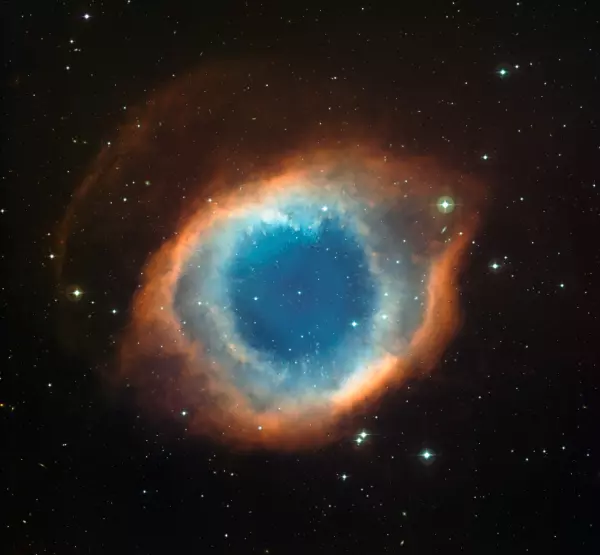
This colour-composite image of the Helix Nebula (NGC 7293) was created from images obtained using the the Wide Field Imager (WFI), an astronomical camera attached to the 2.2-metre Max-Planck Society/ESO telescope at the La Silla observatory in Chile. The blue-green glow in the centre of the Helix comes from oxygen atoms shining under effects of the intense ultraviolet radiation of the 120 000 degree Celsius central star and the hot gas. Further out from the star and beyond the ring of knots, the red colour from hydrogen and nitrogen is more prominent. A careful look at the central part of this object reveals not only the knots, but also many remote galaxies seen right through the thinly spread glowing gas. This image was created from images through blue, green and red filters and the total exposure times were 12 minutes, 9 minutes and 7 minutes respectively. Image: ESO
NGC 2362 (Caldwell 64): Tau Canis Majoris Cluster
The Tau Canis Majoris Cluster (C64) is a bright open cluster located about 4,830 light years away in Canis Major. With an apparent magnitude of 3.8, the cluster is visible to the unaided eye on a clear night. It contains 100 – 150 members and is 6 arcminutes across. Its brightest star, Tau Canis Majoris, is an O-type bright giant classified as a Beta Lyrae variable. The star has a mass of 50 solar masses and is 280,000 times more luminous than the Sun. It has an apparent magnitude of 4.40 and is part of a multiple star system.
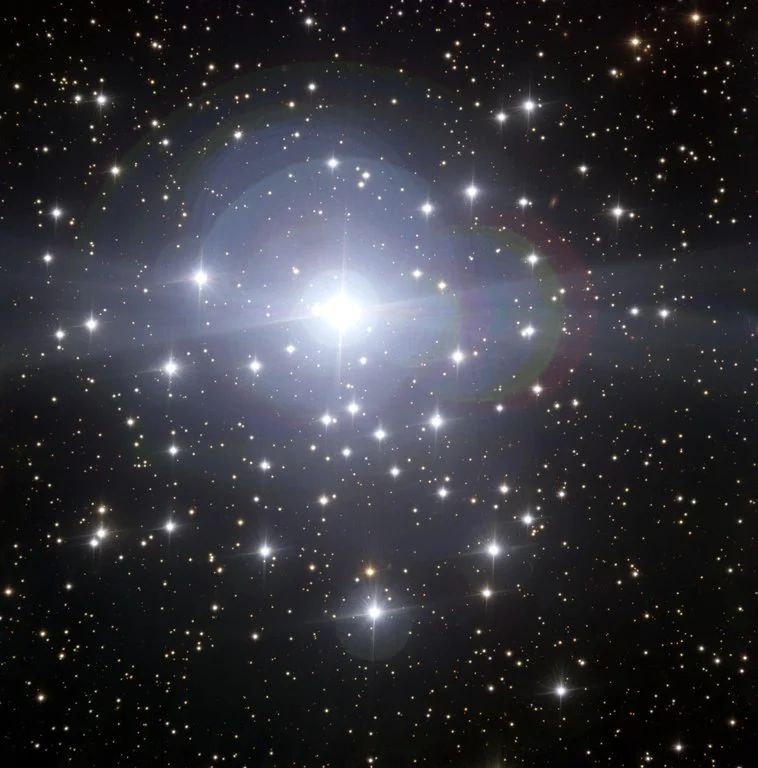
The Tau Canis Majoris Cluster is an open cluster — a group of stars born from the same molecular cloud. This means that all of the cluster’s inhabitants share a common chemical composition and are loosely bound together by gravity. Having been born together, they make an ideal stellar laboratory to test theories of stellar evolution, the chain of events that leads from a star’s birth in a cool, dense cloud of gas through to its eventual end. Though the stars in this image were all created at the same time, their various different masses mean they will lead very different lives. As Tau Canis Majoris is one of the most massive and short-lived types of star, it will burn through its nuclear fuel long before its smaller companions, which will keep on shining for billions of years. Image: ESO
NGC 253 (Caldwell 65): Sculptor Galaxy
The Sculptor Galaxy (C65) is an intermediate spiral galaxy approximately 11.4 million light-years away in the constellation Sculptor. It has an apparent magnitude of 8.0 and an apparent size of 27.5 by 6.8 arcminutes. It is sometimes also called the Silver Coin or Silver Dollar Galaxy. The Sculptor Galaxy is classified as a starburst galaxy. It is undergoing a period of intense star formation. It hosts a supermassive black hole with a mass about 5 million times that of the Sun. The galaxy is 90,000 light years across. It is the brightest member of the Sculptor Group of galaxies.
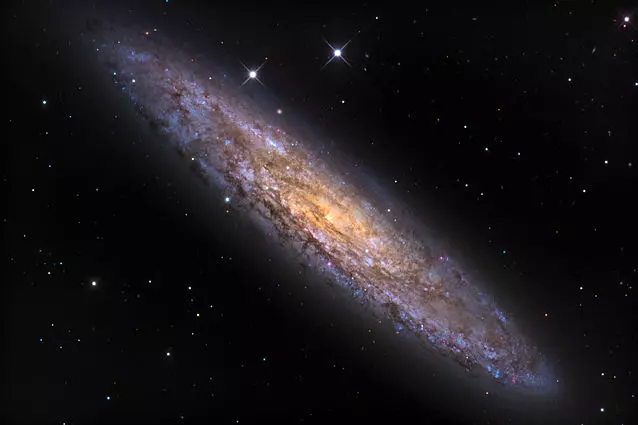
Sculptor Galaxy (NGC 253), image: Adam Block/Mount Lemmon SkyCenter/University of Arizona (CC BY-SA 4.0)
NGC 5694 (Caldwell 66)
NGC 5694 (C66) is a globular cluster approximately 114,100 light years away in the constellation Hydra. It has an apparent magnitude of 10.2 and an apparent size of 3.6 arcminutes. With an estimated age of 12 billion years, it is one of the oldest known globular clusters in the Milky Way.
NGC 1097 (Caldwell 67)
NGC 1097 (C67) is a barred spiral galaxy approximately 45 million light years away in the constellation Fornax. It has two companion galaxies, catalogued as NGC 1097A and NGC 1097B. NGC 1097 hosted three supernovae in recent decades: SN 1992bd, SN1999eu, and SN2003B. The galaxy has an apparent magnitude of 10.2 and an apparent size of 9.3 by 6.3 arcminutes. It is listed as Arp 77 in Halton Arp’s Atlas of Peculiar Galaxies.
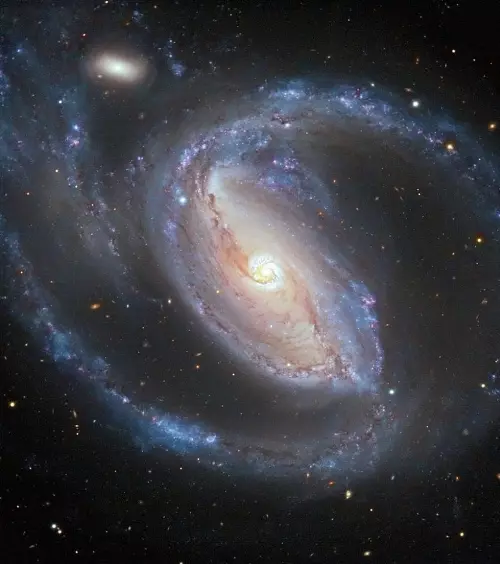
Two galaxies, about 50 million light-years away, are locked in a galactic embrace — literally. The Seyfert galaxy NGC 1097, in the constellation of Fornax (The Furnace), is seen in this image taken with the VIMOS instrument on ESO’s Very Large Telescope (VLT). A comparatively tiny elliptical companion galaxy, NGC 1097A, is also visible in the top left. There is evidence that NGC 1097 and NGC 1097A have been interacting in the recent past. Image: ESO, R. Gendler
NGC 6729 (Caldwell 68): R Coronae Australis Nebula
The R Coronae Australis Nebula (C68) is a variable reflection/emission nebula in the constellation Corona Australis. It stretches from the pre-main-sequence star R Coronae Australis toward the young star T Coronae Australis in the southeast. The nebula has an apparent size of 2.5 by 2.0 arcminutes. It varies both in brightness and in shape over irregular periods. It appears near the magnitude 6.8 globular cluster NGC 6723 (the Chandelier Cluster) in the constellation Sagittarius.
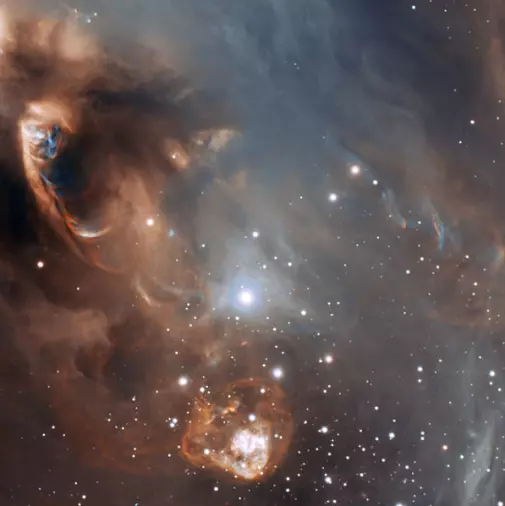
This very detailed false-colour image from ESO’s Very Large Telescope shows the dramatic effects of very young stars on the dust and gas from which they were born in the star-forming region NGC 6729. The baby stars are invisible in this picture, being hidden behind dust clouds at the upper left of the picture, but material they are ejecting is crashing into the surroundings at speeds of that can be as high as one million kilometres per hour. This picture was taken by the FORS1 instrument and records the scene in the light of glowing hydrogen and sulphur. Image: ESO
NGC 6302 (Caldwell 69): Bug Nebula (Butterfly Nebula)
The Bug Nebula (C69) is a bipolar planetary nebula approximately 3,400 light years away in the constellation Scorpius. It lies in the same area of the sky as the Cat’s Paw Nebula (NGC 6334). Notable for its hourglass shape, the Bug Nebula is one of the most complex planetary nebulae known. It spans more than 3 arcminutes and shines at magnitude 7.1. Its central white dwarf is one of the hottest stars known, with an effective temperature of more than 250,000° C. The star has a mass of about 0.64 solar masses.
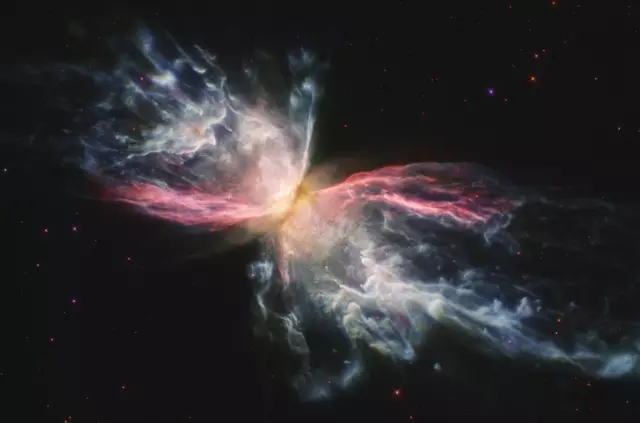
The Butterfly Nebula (NGC 6302), image: Judy Schmidt (CC BY 2.0)
NGC 300 (Caldwell 70)
NGC 300 (C70) is a spiral galaxy located in the direction of Sculptor. It has an apparent magnitude of 9.0 and lies about 6.7 million light years away. The galaxy has an apparent size of 21.9 by 15.5 arcminutes, corresponding to a physical diameter of 94,000 light years. It is believed to form a gravitationally bound pair with the barred spiral galaxy NGC 55 (C72).
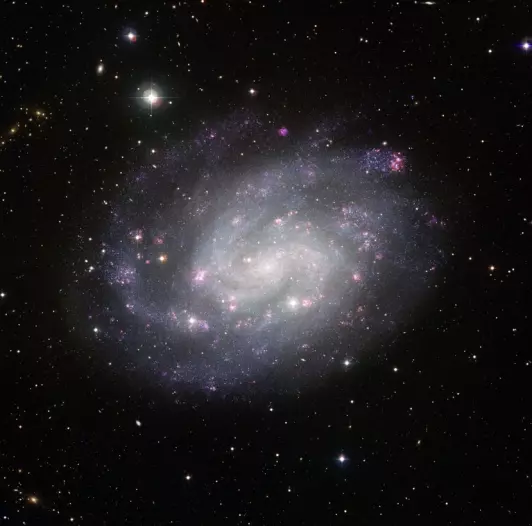
This picture of the spectacular southern spiral galaxy NGC 300 was taken using the Wide Field Imager (WFI) at ESO’s La Silla Observatory in Chile. Image: ESO
NGC 2477 (Caldwell 71)
NGC 2477 (C71) is an open cluster approximately 3,600 light years away in the constellation Puppis. It has an apparent magnitude of 5.8 and is 27 arcminutes across. The cluster contains about 300 stars and has an estimated age of about 700 million years. It appears near the blue supergiant Naos (Zeta Puppis).
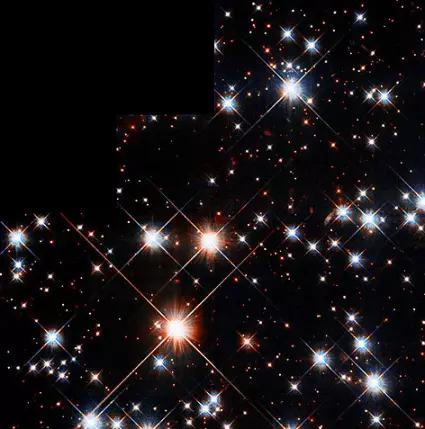
Caldwell 71 (NGC 2477), image: NASA, ESA, and T. von Hippel (Embry-Riddle Aeronautical University); Processing: Gladys Kober (NASA/Catholic University of America)
NGC 55 (Caldwell 72): String of Pearls Galaxy
NGC 55 (C72) is a Magellanic-type barred spiral galaxy approximately 6.5 million light years away in the constellation Sculptor. It appears near Ankaa (Alpha Phoenicis), the brightest star in Phoenix. The galaxy has an apparent magnitude of 7.87 and an apparent size of 32.4 by 5.6 arcminutes. It is likely gravitationally bound to NGC 300 (C70). NGC 55 shares the nickname the Whale Galaxy with NGC 4631 (C32) in Canes Venatici. It is also popularly known as the String of Pearls Galaxy.
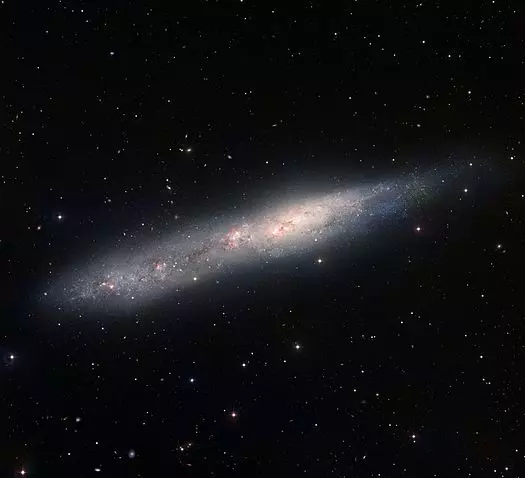
Image of the irregular galaxy NGC 55 obtained with the Wide Field Imager on the 2.2-metre MPG/ESO telescope at ESO La Silla Observatory. The galaxy is about 7.5 million light-years away and 70 000 light-years across. Image: ESO
NGC 1851 (Caldwell 73)
NGC 1851 (C73) is a globular cluster located 39,500 light years away in the constellation Columba. It has an apparent magnitude of 7.3 and an angular size of 11 arcminutes. It has one of the densest central concentrations of all known globular clusters in the Milky Way. The estimated age of the cluster is 9.2 billion years.
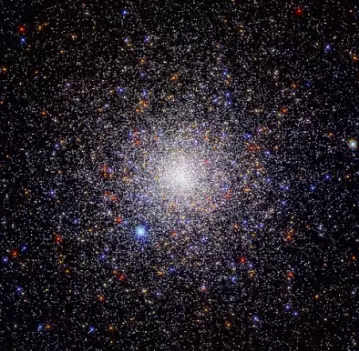
Caldwell 73 (NGC 1851), image: NASA, ESA, and G. Piotto (Università degli Studi di Padova); Processing: Gladys Kober (NASA/Catholic University of America)
NGC 3132 (Caldwell 74): Southern Ring Nebula (Eight-Burst Nebula)
The Southern Ring Nebula (C74) is a planetary nebula approximately 2,000 light years away in the southern constellation Vela. It has an apparent magnitude of 9.87 and an apparent size of 62 by 43 arcseconds. It was nicknamed the Southern Ring Nebula for its resemblance to the brighter and larger Ring Nebula (Messier 57) in Lyra. NGC 3132 has a radius of 0.4 light years. Its central star is a 16th magnitude hot white dwarf.
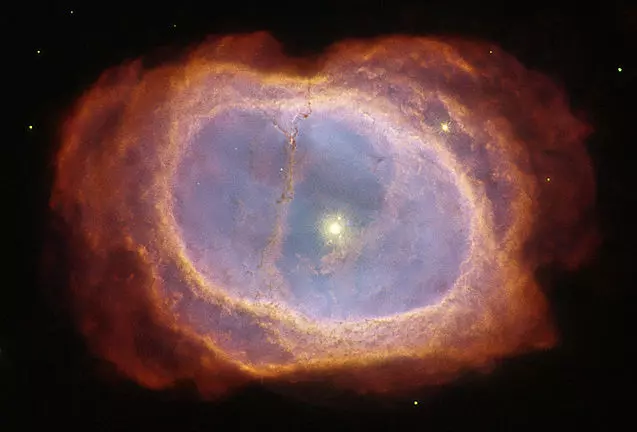
Eight Burst Nebula (Southern Ring Nebula, NGC 3132), image: Judy Schmidt (CC BY 2.0)
NGC 6124 (Caldwell 75)
NGC 6124 (C75) is a bright open star cluster located in the region of the Scorpion’s tail in Scorpius. It lies 18,600 light years away. With an apparent magnitude of 5.8 and an apparent size of 29 arcminutes, the cluster is easily observed in binoculars and small telescopes.
NGC 6231 (Caldwell 76) – Northern Jewel Box Cluster
NGC 6231 (C76) is an open cluster approximately 5,600 light years away in Scorpius. It appears about half a degree north of Zeta Scorpii and is part of the False Comet asterism. The cluster is sometimes called the Northern Jewel Box because it resembles the Jewel Box Cluster (NGC 4755) in the southern constellation Crux. NGC 6231 has an apparent magnitude of 2.6 and spans 15 arcminutes of the apparent sky. Its estimated age is between 2 and 7 million years.
NGC 5128 (Caldwell 77): Centaurus A
Centaurus A (C77) is a bright galaxy located 10 – 16 million light years away in the constellation Centaurus. It is uncertain whether it is a giant elliptical or lenticular galaxy. It has an apparent magnitude of 6.84 and an apparent size of 25.7 by 20 arcminutes. Centaurus A is one of the nearest radio galaxies to the Sun and the fifth brightest galaxy in the sky, after the Large and Small Magellanic Clouds, the Andromeda Galaxy (M31) and the Triangulum Galaxy (M33).
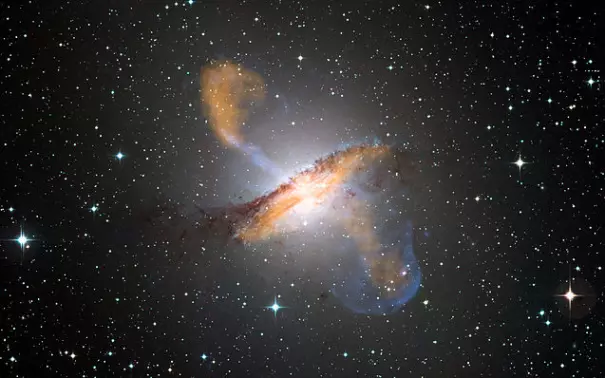
Colour composite image of Centaurus A, revealing the lobes and jets emanating from the active galaxy’s central black hole. This is a composite of images obtained with three instruments, operating at very different wavelengths. The 870-micron submillimetre data, from LABOCA on APEX, are shown in orange. X-ray data from the Chandra X-ray Observatory are shown in blue. Visible light data from the Wide Field Imager (WFI) on the MPG/ESO 2.2 m telescope located at La Silla, Chile, show the stars and the galaxy’s characteristic dust lane is close to “true colour”. Image: ESO/WFI (Optical); MPIfR/ESO/APEX/A.Weiss et al. (Submillimetre); NASA/CXC/CfA/R.Kraft et al. (X-ray)
NGC 6541 (Caldwell 78)
NGC 6541 (C78) is a globular cluster approximately 22,800 light years away in Corona Australis. It has an apparent magnitude of 6.3 and an apparent size of 15 arcminutes. Its estimated age is about 14 billion years.
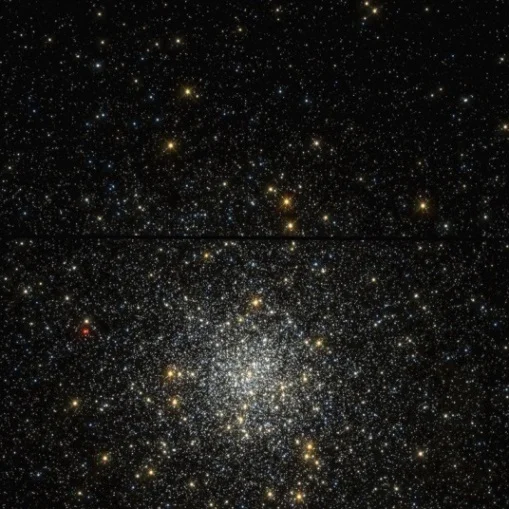
Globular cluster NGC 6541 in Corona Australis. Based on observations made with the NASA/ESA Hubble Space Telescope, and obtained from the Hubble Legacy Archive, which is a collaboration between the Space Telescope Science Institute (STScI/NASA), the Space Telescope European Coordinating Facility (ST-ECF/ESA) and the Canadian Astronomy Data Centre (CADC/NRC/CSA).
NGC 3201 (Caldwell 79)
NGC 3201 (C79) is a globular cluster in the constellation Vela. It lies 16,300 light years away and has an apparent magnitude of 8.24. It occupies 18.2 arcminutes of the apparent sky, which corresponds to a physical radius of 40 light years. The estimated age of the cluster is 12.2 billion years.
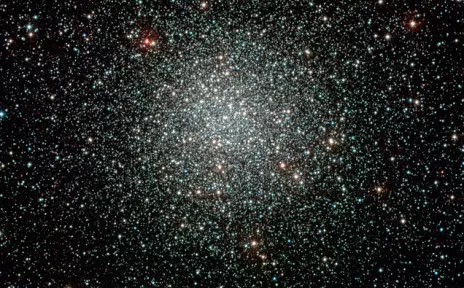
Colour-composite image of the globular cluster NGC 3201, obtained with the WFI instrument on the ESO/MPG 2.2-m telescope at La Silla. Globular clusters are large aggregates of stars, that can contain up to millions of stars. They are among the oldest objects observed in the Universe and were presumably formed at about the same time as the Milky Way Galaxy, in the early phase after the Big Bang. This particular globular cluster is located about 16 000 light-years away towards the southern Vela constellation. The data were obtained as part of the ESO Imaging Survey (EIS), a public survey being carried out by ESO and member states, in preparation for the VLT First Light. The original image and astronomical data can be retrieved from the EIS Pre-Flames Survey Data Release pages, where many other nice images are also available. Image: ESO
NGC 5139 (Caldwell 80): Omega Centauri
Omega Centauri (C80) is a bright globular cluster approximately 15,800 light years away in Centaurus. With an apparent magnitude of 3.9 and an apparent size of 36.3 arcminutes, it is visible to the unaided eye. Omega Centauri is the largest known globular cluster in our galaxy, with a diameter of about 150 light years. It is believed to contain about 10 million stars. The cluster is thought to be the core remnant of a dwarf galaxy that was absorbed by the Milky Way in the distant past.
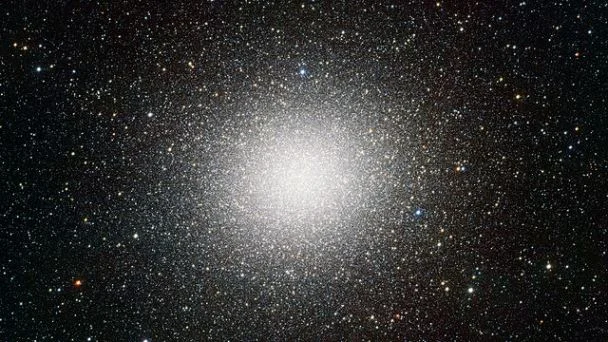
The second released VST image may be the best portrait of the globular star cluster Omega Centauri ever made. Omega Centauri, in the constellation of Centaurus (the Centaur), is the largest globular cluster in the sky, but the very wide field of view of VST and its powerful camera OmegaCAM can encompass even the faint outer regions of this spectacular object. This view includes about 300 000 stars. The data were processed using the VST-Tube system developed by A. Grado and collaborators at the INAF-Capodimonte Observatory. Image: ESO/INAF-VST/OmegaCAM. Acknowledgement: A. Grado/INAF-Capodimonte Observatory
NGC 6352 (Caldwell 81)
NGC 6352 (C81) is a globular cluster approximately 18,300 light years away in the constellation Ara. It has an apparent magnitude of 7.8 and an apparent size of 7.1 arcminutes. Its estimated age is 12.67 billion years. The brightest stars in the cluster can be resolved in a 6-inch telescope.
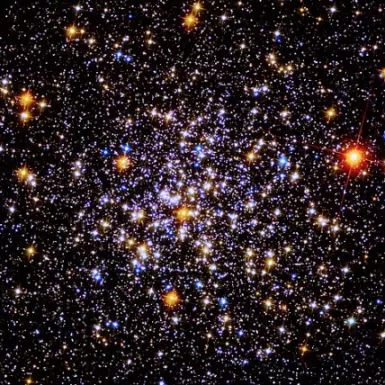
Caldwell 81 (NGC 6352), image: NASA, ESA, A. Sarajedini (Florida Atlantic University), A. Kong (National Tsing Hua University), and G. Piotto (Università degli Studi di Padova); Processing: Gladys Kober (NASA/Catholic University of America)
NGC 6193 (Caldwell 82)
NGC 6193 (C82) is an open star cluster located 3,765.3 light years away in Ara. With an apparent magnitude of 5.2, the cluster is visible to the unaided eye. It has an apparent size of 15 arcminutes. NGC 6193 is associated with the emission nebula NGC 6188. It illuminates a region of reflection nebulosity within the nebula.
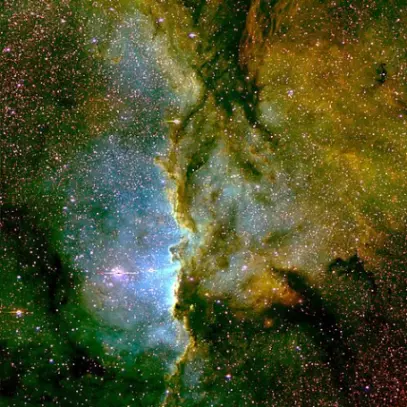
NGC 6193. Photo by Rbarba. Three-colors image of NGC 6193 and NGC 6188 obtained with the Curtis-Schmidt telescope at Cerro Tololo Inter-American Observatory (Chile).
NGC 4945 (Caldwell 83)
NGC 4945 (C83) is a barred spiral galaxy located approximately 11.7 million light years away in Centaurus. It appears only 17 arcminutes east of the magnitude 4.83 star Xi1 Centauri. The galaxy has an apparent magnitude of 9.3 and an apparent size of 20 by 3.8 arcminutes. It is one of the brightest members of the Centaurus A/M83 Group.
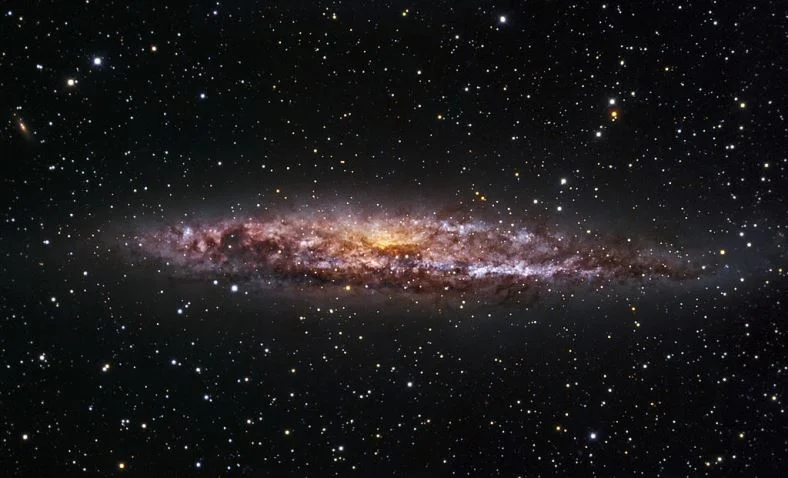
NGC 4945, image: ESO, IDA, Danish 1.5 m, R. Gendler and C. Thöne
NGC 5286 (Caldwell 84)
NGC 5286 (C84) is a globular cluster approximately 35,900 light years away in Centaurus constellation. It appears 4 arcminutes north of the magnitude 4.64 yellow giant M Centauri. The cluster has an apparent magnitude of 7.6 and is 4 arcminutes across. Its estimated age is 12.54 billion years. The cluster is part of the Gaia Sausage, the hypothesized remains of a dwarf galaxy that merged with the Milky Way 8-11 billion years ago. NGC 5286 is one of at least eight globular clusters believed to have been added to our galaxy after the merger.
IC 2391 (Caldwell 85): Omicron Velorum Cluster
The Omicron Velorum Cluster (C85) is a magnitude 2.5 open cluster located 574 light years away in the constellation Vela. Located just north of Alsephina (Delta Velorum), the cluster is visible to the unaided eye. It is centred on Omicron Velorum, a hot blue subgiant with an apparent magnitude of 3.60. The cluster occupies 50 arcminutes of the apparent sky. Its estimated age is 50 million years.
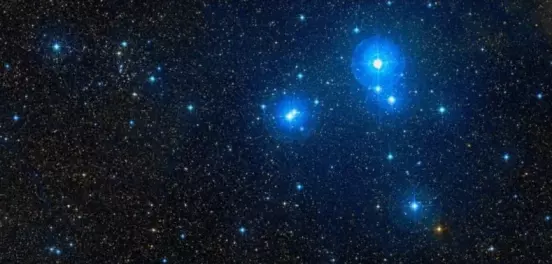
The Omicron Velorum Cluster (IC 2391) and NGC 2669, image: Wikisky
NGC 6397 (Caldwell 86)
NGC 6397 (C86) is a globular cluster 7,800 light years away in the constellation Ara. It has an apparent magnitude of 6.68 and an apparent size of 32 arcminutes. It is one of the closest globular clusters to the Sun, along with Messier 4 (7,200 ly) in Scorpius. NGC 6397 has a radius of 34 light years. Its estimated age is 13.4 billion years.
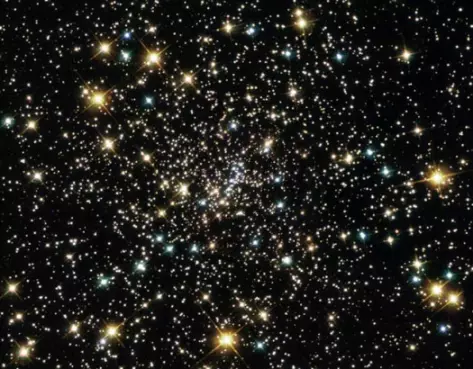
NGC 6397, photo: NASA/ESA and the Hubble Heritage Team (AURA/STScI)
NGC 1261 (Caldwell 87)
NGC 1261 (C87) is a globular cluster located in the constellation Horologium. It has an apparent magnitude of 8.63 and lies 53,500 light years away. The cluster occupies 12.9 arcminutes of the apparent sky. It has an estimated age of 10.24 billion years.
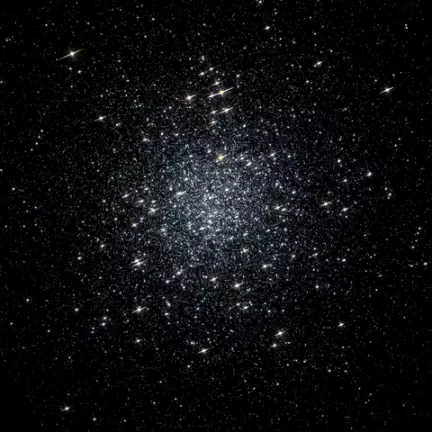
NGC 1261, image based on observations made with the NASA & ESA Hubble Space Telescope, and obtained from the Hubble Legacy Archive, which is a collaboration between the Space Telescope Science Institute, the Space Telescope European Coordinating Facility and the Canadian Astronomy Data Centre.
NGC 5823 (Caldwell 88)
NGC 5823 (C88) is an open star cluster approximately 3,890 light years away in the constellation Circinus. It extends across the border into Lupus. It has an apparent magnitude of 7.9.
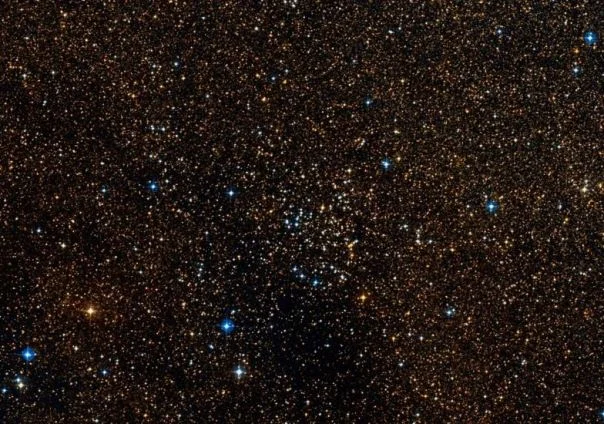
NGC 5823, image: Wikisky
NGC 6087 (Caldwell 89): S Normae Cluster
The S Normae Cluster (C89) is an open cluster 3,500 light years away in Norma. It has an apparent magnitude of 5.4 and is 12 arcminutes across. It is centred on S Normae, a magnitude 6.394 yellow supergiant classified as a Cepheid variable. The cluster contains at least 40 stars.
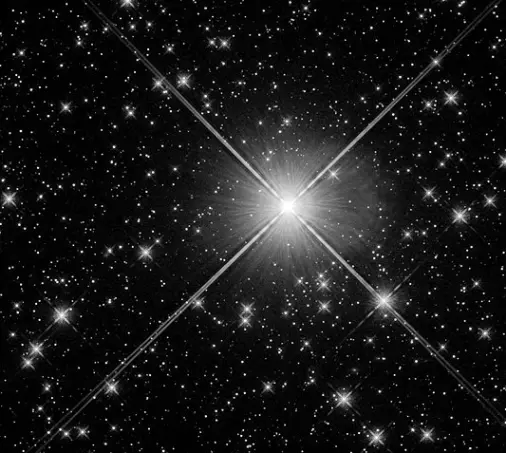
This shining collection of stars captured in infrared light by Hubble’s Wide Field Camera 3 is part of Caldwell 89, also known as NGC 6087. This open cluster consists of approximately 40 stars, the brightest of which (near the center here) is the variable star S Normae. Image: NASA, ESA, and A. Riess (Johns Hopkins University); Processing: Gladys Kober (NASA/Catholic University of America)
NGC 2867 (Caldwell 90)
NGC 2867 (C90) is a planetary nebula located 7,270 light years away in Carina. It appears just over a degree north-northwest of the white supergiant Aspidiske (Iota Carinae). The nebula is elliptical in shape. It has an apparent magnitude of 9.7.
NGC 3532 (Caldwell 91): Wishing Well Cluster
The Wishing Well Cluster (C91) is an open cluster in the constellation Carina. It appears in the same region of the sky as the Carina Nebula (C92). The cluster lies 1,321 light years away and has an apparent magnitude of 3. In May 1990, it became the first target to be observed by the Hubble Space Telescope. NGC 3532 is also known as the Football Cluster, Pincushion Cluster, or Black Arrow Cluster.
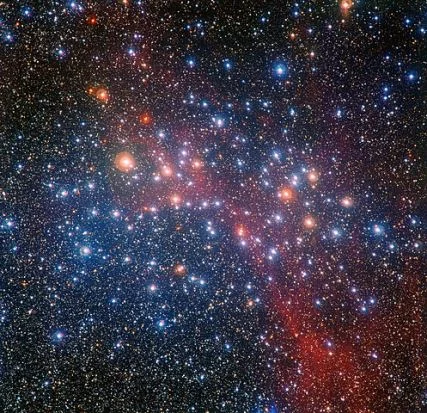
The MPG/ESO 2.2-metre telescope at ESO’s La Silla Observatory in Chile captured this richly colourful view of the bright star cluster NGC 3532. Some of the stars still shine with a hot bluish colour, but many of the more massive ones have become red giants and glow with a rich orange hue. Image: ESO/G. Beccari
NGC 3372 (Caldwell 92): Carina Nebula
The Carina Nebula (C92) is a vast nebula approximately 8,500 light years away in the constellation Carina. Consisting of both bright and dark nebulosity, the nebula appears 120 arcminutes across and has a physical radius of 230 light years. With an apparent magnitude of 1.0, it is visible to the unaided eye. It is both brighter and four times larger than the Orion Nebula. The Carina Nebula is home to some of the most luminous stars in our galaxy, including the luminous blue variable Eta Carinae and the Wolf-Rayet star WR 25.
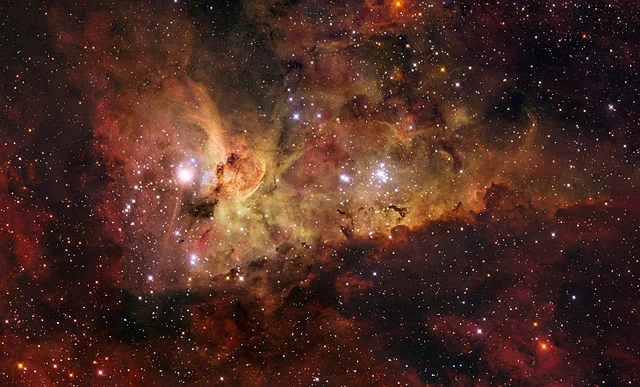
The Carina Nebula is a large bright nebula that surrounds several clusters of stars. It contains two of the most massive and luminous stars in our Milky Way galaxy, Eta Carinae and HD 93129A. Located 7500 light years away, the nebula itself spans some 260 light years across, about 7 times the size of the Orion Nebula, and is shown in all its glory in this mosaic. It is based on images collected with the 1.5-m Danish telescope at ESO’s La Silla Observatory. Being brighter than one million Suns, Eta Carinae (the brightest star in this image) is the most luminous star known in the Galaxy, and has most likely a mass over 100 times that of the Sun. It is the closest example of a luminous blue variable, the last phase in the life of a very massive star before it goes out in a fiery supernova. Eta Carinae is surrounded by an expanding bipolar cloud of dust and gas known as the Homunculus (little man in Latin), which astronomers believe was expelled from the star during a great outburst seen in 1843. Image: ESO/IDA/Danish 1.5 m/R.Gendler, J-E. Ovaldsen, C. Thöne, and C. Feron.
NGC 6752 (Caldwell 93): Great Peacock Globular
The Great Peacock Globular (C93) is a magnitude 5.4 globular cluster located in the direction of the constellation Pavo, the Peacock. The cluster lies 13,000 light years away and has an apparent size of 20.4 arcminutes. It is the fourth brightest globular cluster in the sky. It has an estimated age of 11.78 billion years.
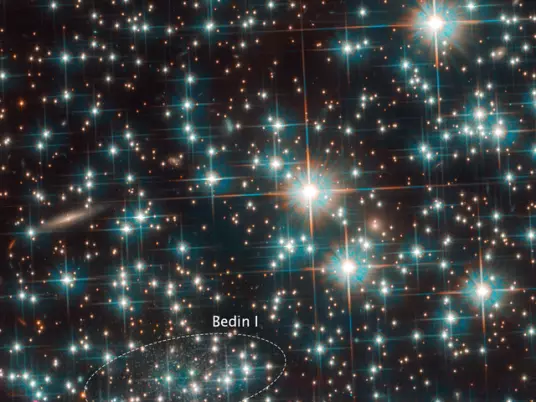
This is a Hubble Space Telescope image of a concentration of stars within the globular cluster NGC 6752. Hidden among the stars is an image of a background galaxy that is much farther away. The diminutive galaxy, named by its discoverers as Bedin 1, measures only around 3,000 light-years at its greatest extent — a fraction of the size of the Milky Way. Not only is it tiny, but it is also incredibly faint. These properties led astronomers to classify it as a dwarf spheroidal galaxy that is as old as the universe. Image: NASA, ESA, and L. Bedin (Astronomical Observatory of Padua, Italy)
NGC 4755 (Caldwell 94): Jewel Box Cluster
The Jewel Box Cluster (C94) is a bright open cluster 6,440 light years away in the constellation Crux. It appears a degree southeast of the blue giant Mimosa (Beta Crucis). The cluster is very young, with an estimated age of only 14 million years. It contains more than 100 stars. It has an apparent magnitude of 4.2 and is one of the finest telescope targets in the far southern sky.
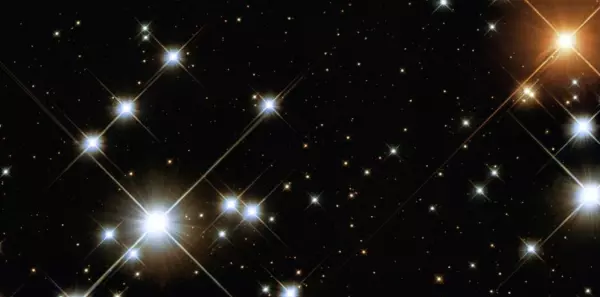
This image is a “close-up” view from the NASA/ESA Hubble Space Telescope of NGC 4755, or the Jewel Box Cluster. Several very bright, pale blue super-giant stars (eg. κ Crucis on the left, HD 111934 on the lower right and HIP 62913 in the middle right), a solitary ruby-red super-giant (HIP 62918 – upper right) and a variety of other brilliantly coloured stars are visible in the image, as well as many much fainter ones, often with intriguing colours. The huge variety in brightness exists because the brighter stars are 15 to 20 times the mass of the Sun, while the dim points are less than half the mass of the Sun. This is the first image of an open galactic cluster with imaging extending from the far ultraviolet to the near-infra-red. Image: NASA/ESA and Jesús Maíz Apellániz (Instituto de Astrofísica de Andalucía, Spain), 2009
NGC 6025 (Caldwell 95)
NGC 6025 (C95) is a bright open star cluster in the constellation Triangulum Australe. It has an apparent magnitude of 5.1 and lies approximately 2,700 light years away. It occupies 12 arcminutes of the apparent sky.
NGC 2516 (Caldwell 96): Southern Beehive Cluster
The Southern Beehive (C96) is an open cluster approximately 1,300 light years away in the constellation Carina. With an apparent magnitude of 3.8, it is visible to the unaided eye. Its brightest stars can be resolved in binoculars. The cluster has an apparent size of 30 arcminutes. It appears near Avior (Epsilon Carinae). It was nicknamed the Southern Beehive because it resembles the Beehive Cluster (Messier 44) in the constellation Cancer. The cluster is sometimes also called the Sprinter.
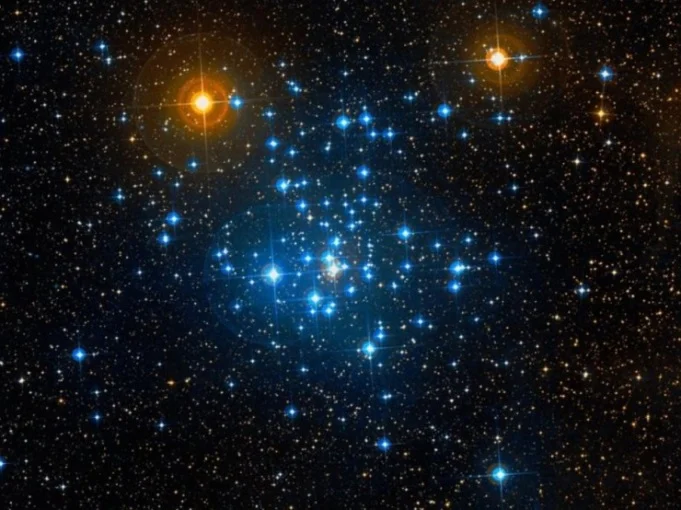
The Southern Beehive Cluster (NGC 2516), image: Wikisky
NGC 3766 (Caldwell 97): Pearl Cluster
The Pearl Cluster (C97) is an open cluster 5,500 light years away in Centaurus constellation. It has an apparent magnitude of 5.3 and an apparent size of 12 arcminutes, corresponding to a physical radius of 9.6 light years. The cluster lies within the Carina molecular cloud. It contains 36 unusual fast-rotating pulsating B-type variable stars. It is easily observed in a small telescope.
NGC 4609 (Caldwell 98)
NGC 4609 (C98) is an open cluster about 4,000 light years away in the constellation Crux. It appears near Acrux, the constellation’s brightest star, in the region of the Coalsack Nebula. The cluster has an apparent magnitude of 6.9 and is 5 arcminutes across.
Coalsack Nebula (Caldwell 99)
The Coalsack Nebula (C99) is the most striking dark nebula in the sky. It stretches across an area of almost 7 by 5 degrees in the constellation Crux, overlapping into the neighbouring Centaurus and Musca. The nebula has a radius of 30 to 35 light years. It appears as a dark patch on the Milky Way east of Acrux in the Southern Cross. It lies approximately 590 light years away.
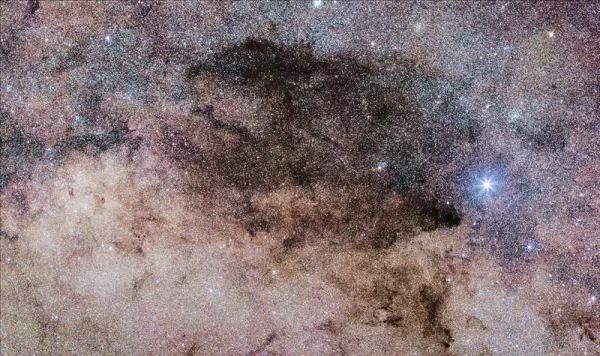
Coalsack Nebula, image: Wikimedia Commons/Naskies (CC BY-SA 3.0)
IC 2944 (Caldwell 100): Lambda Centauri Nebula
The Lambda Centauri Nebula (C100) is an open cluster associated with an emission nebula about 6,500 light years away in Centaurus. The nebula is sometimes also called the Running Chicken Nebula. It has an apparent magnitude of 4.5 and stretches across 75 arcminutes of the apparent sky. It has a physical radius of 71 light years. The blue giant Lambda Centauri appears just outside the region. It is located much closer to us, at a distance of 470 light years.
NGC 6744 (Caldwell 101)
NGC 6744 (C101) is an intermediate spiral galaxy located in the constellation Pavo. It lies about 31 million light years away. It has an apparent magnitude of 9.14 and an apparent size of 20 by 12.9 arcminutes. The galaxy has at least one companion, catalogued as NGC 6744A.
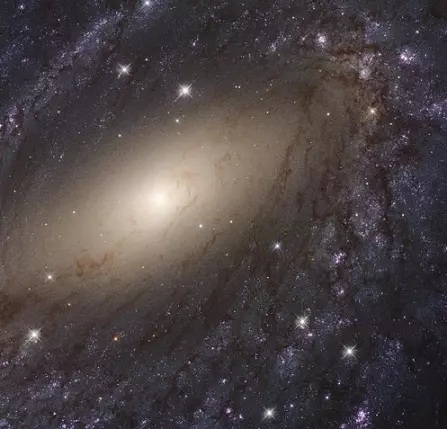
Caldwell 101 (NGC 6744), image: NASA, ESA and the LEGUS team
IC 2602 (Caldwell 102): Theta Carinae Cluster (Southern Pleiades)
The Theta Carinae Cluster (C102) is an exceptionally bright and large open cluster approximately 547 light years away in Carina. With an apparent magnitude of 1.9 and an apparent size of 50 arcminutes, the cluster is easily visible to the unaided eye. Nicknamed the Southern Pleiades, IC 2602 is the third brightest open cluster in the sky, after the Pleiades and the Hyades. It has an estimated age of 13.7 million years. The brightest star in the cluster, Theta Carinae, is a hot blue B-type star with an apparent magnitude of 2.76. It marks one of the vertices of the Diamond Cross asterism.
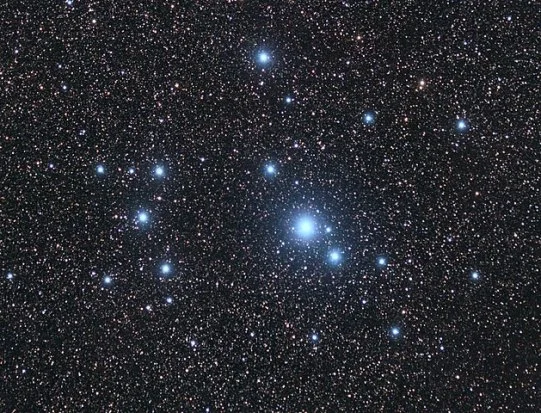
Theta Carinae Cluster – the Southern Pleiades, image: Wikimedia Commons/Tel Lekatsas (CC BY 2.0)
NGC 2070 (Caldwell 103): Tarantula Nebula
NGC 2070 (C103) is an open cluster at the centre of the Tarantula Nebula (30 Doradus), a large H II region in the Large Magellanic Cloud (LMC). It lies 157,000 light years away in the constellation Dorado. It has an apparent magnitude of 7.25 and an apparent size of 3.50 by 3.50 arcminutes. The central concentration of stars in NGC 2070 is catalogued as R136. The R136 cluster is home to some of the most massive and luminous stars known, including R136a1, a Wolf-Rayet star with an estimated mass between 184 and 260 solar masses and a luminosity 6,166,000 times that of the Sun. The star is only about a million years old.
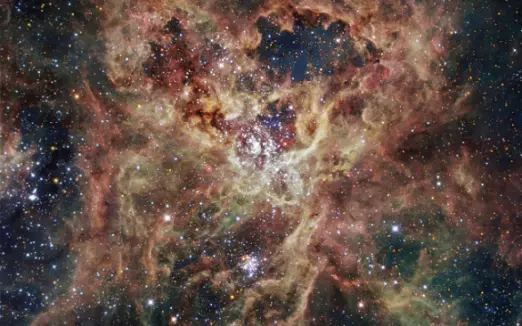
Located inside the Large Magellanic Cloud (LMC) – one of our closest galaxies – in what some describe as a frightening sight, the Tarantula nebula is worth looking at in detail. Also known as 30 Doradus or NGC 2070, the nebula owes its name to the arrangement of its bright patches that somewhat resemble the legs of a tarantula. Taking the name of one of the biggest spiders on Earth is very fitting in view of the gigantic proportions of this celestial nebula — it measures nearly 1,000 light years across! Its proximity, the favourable inclination of the LMC, and the absence of intervening dust make this nebula one of the best laboratories to better understand the formation of massive stars. This spectacular nebula is energised by an exceptionally high concentration of massive stars, often referred to as super star clusters. Image: ESO/IDA/Danish 1.5 m/R. Gendler, C. C. Thöne, C. Féron, and J.-E. Ovaldsen
NGC 362 (Caldwell 104)
NGC 362 (C104) is a globular cluster about 29,290 light years away in the constellation Tucana. It has an apparent magnitude of 6.4 and an apparent size of 12.9 arcminutes. Its estimated age is about 11 billion years. The cluster appears slightly north of the Small Magellanic Cloud. It is visible to the unaided eye in good conditions.
NGC 4833 (Caldwell 105)
NGC 4833 (C105) is a globular cluster in the constellation Musca, the Fly. It lies approximately 21,500 light years away and appears near the magnitude 3.61 giant star Delta Muscae. The cluster has an apparent magnitude of 7.79 and occupies 13.5 arcminutes of the apparent sky. It has a physical radius of 42 light years. The estimated age of NGC 4833 is 12.54 billion years.
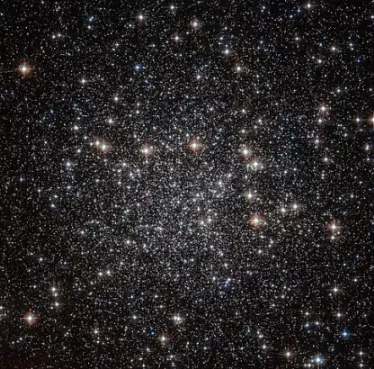
Located approximately 22 000 light-years away in the constellation of Musca (The Fly), this tightly packed collection of stars — known as a globular cluster — goes by the name of NGC 4833. This NASA/ESA Hubble Space Telescope image shows the dazzling stellar group in all its glory. NGC 4833 is one of the over 150 globular clusters known to reside within the Milky Way. These objects are thought to contain some of the oldest stars in our galaxy. Studying these ancient cosmic clusters can help astronomers to unravel how a galaxy formed and evolved, and give an idea of the galaxy’s age. Globular clusters are responsible for some of the most striking sights in the cosmos, with hundreds of thousands of stars congregating in the same region of space. Hubble has observed many of these clusters during its time in orbit around our planet, each as breathtaking as the last. Image: ESA/Hubble and NASA
NGC 104 (Caldwell 106): 47 Tucanae
47 Tucanae (C106) is the second brightest globular cluster in the sky after Omega Centauri (C80). It has an apparent magnitude of 4.09 and an apparent size of 30.9 arcminutes. It appears near the Small Magellanic Cloud (SMC). The cluster is 120 light years in diameter and lies approximately 13,000 light years away. It has an estimated age of 13.06 billion years.
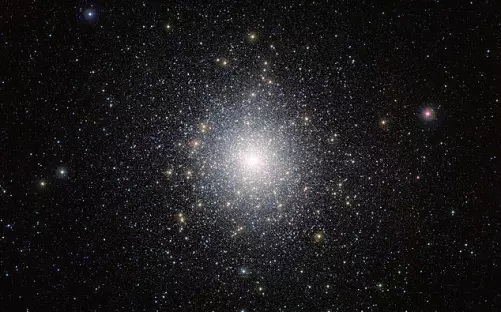
This bright cluster of stars is 47 Tucanae (NGC 104), shown here in an image taken by ESO’s VISTA (Visible and Infrared Survey Telescope for Astronomy) from the Paranal Observatory in Chile. This cluster is located around 15 000 light-years away from us and contains millions of stars, some of which are unusual and exotic. This image was taken as part of the VISTA Magellanic Cloud survey, a project that is scanning the region of the Magellanic Clouds, two small galaxies that are very close to our Milky Way. Image: ESO/M.-R. Cioni/VISTA Magellanic Cloud survey
NGC 6101 (Caldwell 107)
NGC 6101 (C107) is a globular cluster about 47,600 light years away in the constellation Apus. It has an apparent magnitude of 9 and an apparent size of 10.7 arcminutes. Individual stars in the cluster can be resolved with an 8-inch or larger telescope. NGC 6101 has an estimated age of 12.54 billion years.
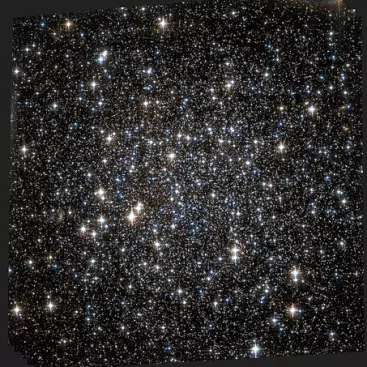
NGC 6101, image: NASA (Hubble Space Telescope)
NGC 4372 (Caldwell 108)
NGC 4372 (C108) is a globular cluster 18,900 light years away in the constellation Musca. It appears southwest of the hot blue star Gamma Muscae. It has an apparent magnitude of 9.85 and is 18 arcminutes across. It has an estimated age of 12.54 billion years.
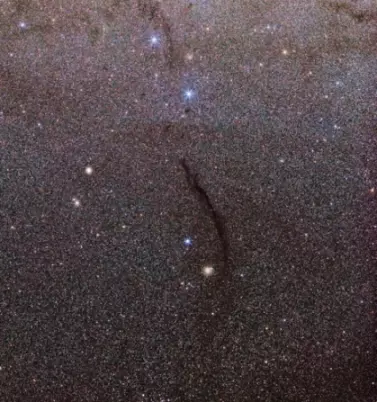
The Dark Doodad Nebula, with globular cluster NGC 4372 at its southern end. Image: Wikimedia Commons/Naskies (CC BY-SA 3.0)
NGC 3195 (Caldwell 109)
NGC 3195 (C109) is a planetary nebula approximately 6,440 light years away in the southern constellation Chamaeleon. It has an apparent magnitude of 11.6 and an apparent size of 1.33 arcminutes. It can be seen in 4-inch telescopes. The nebula’s central star is a binary system.
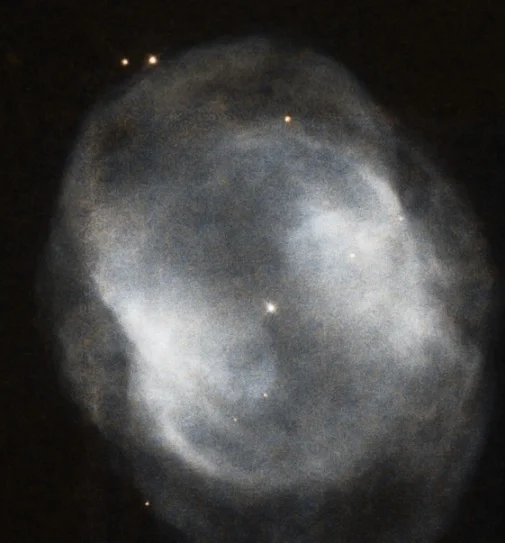
The planetary nebula NGC 3195, image: Judy Schmidt (CC BY 2.0)